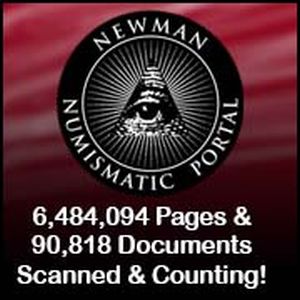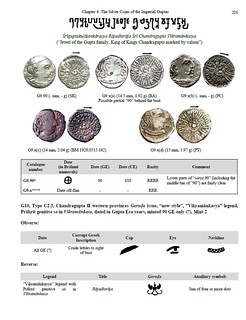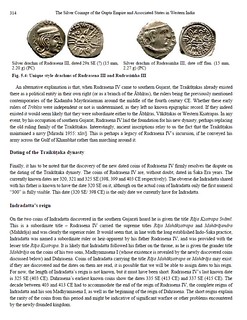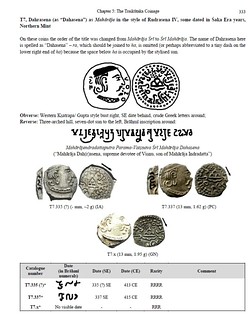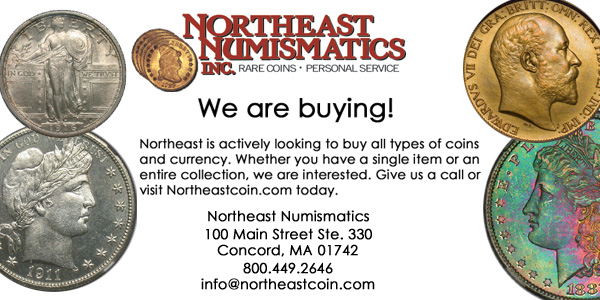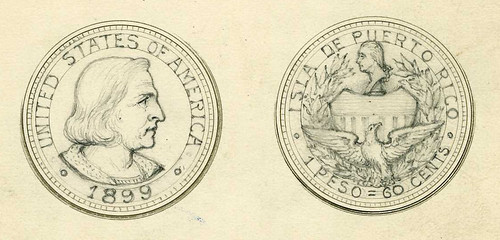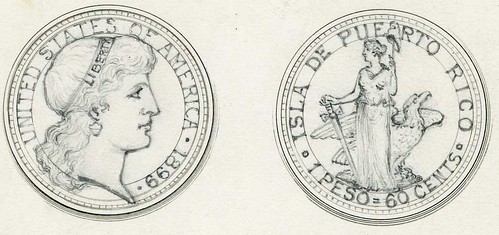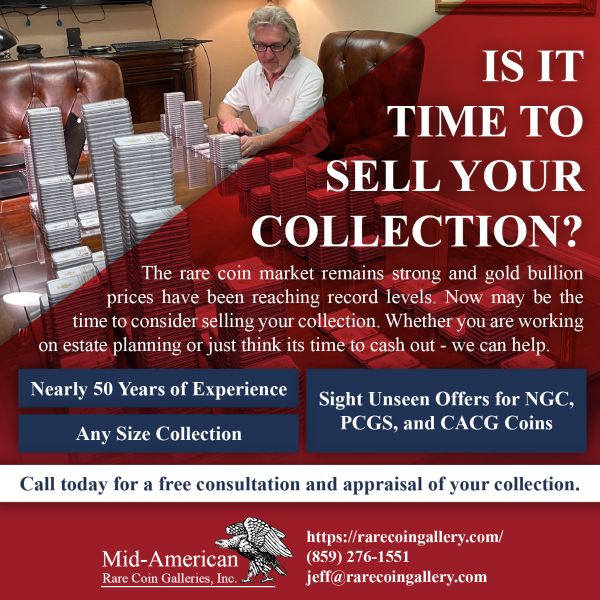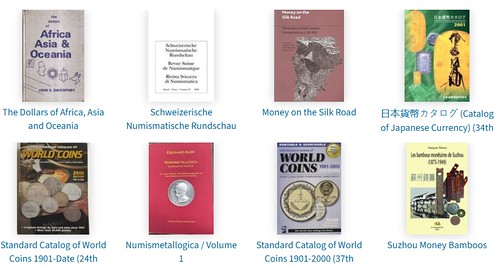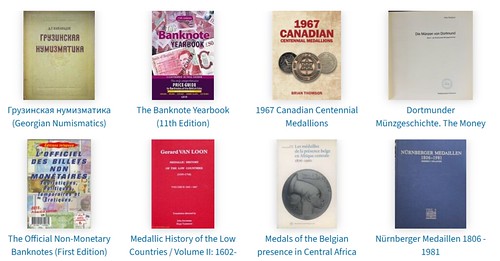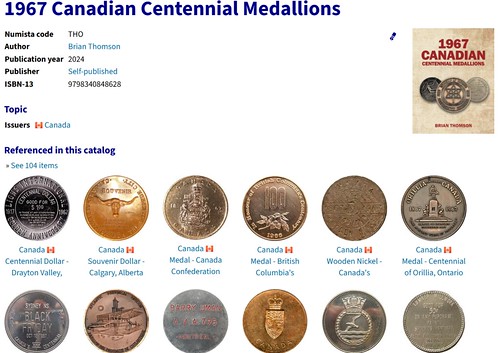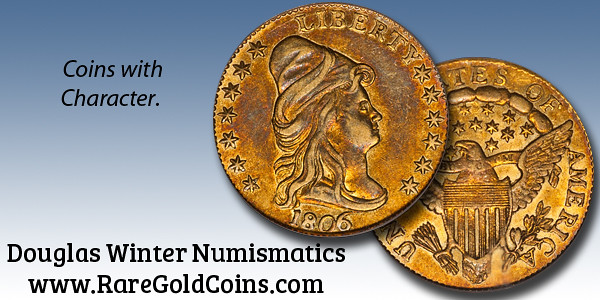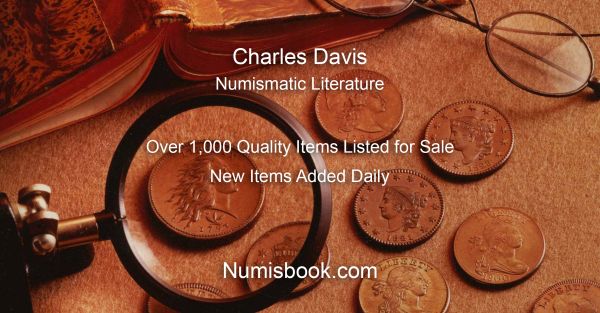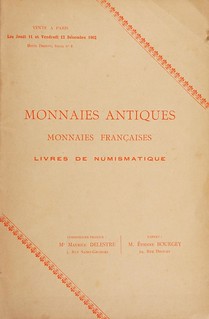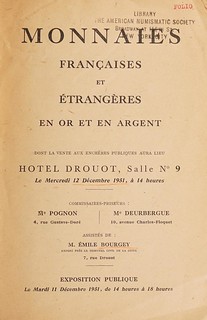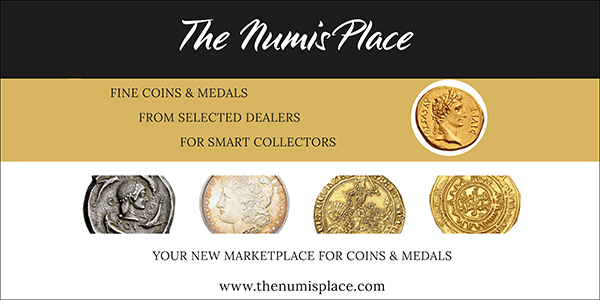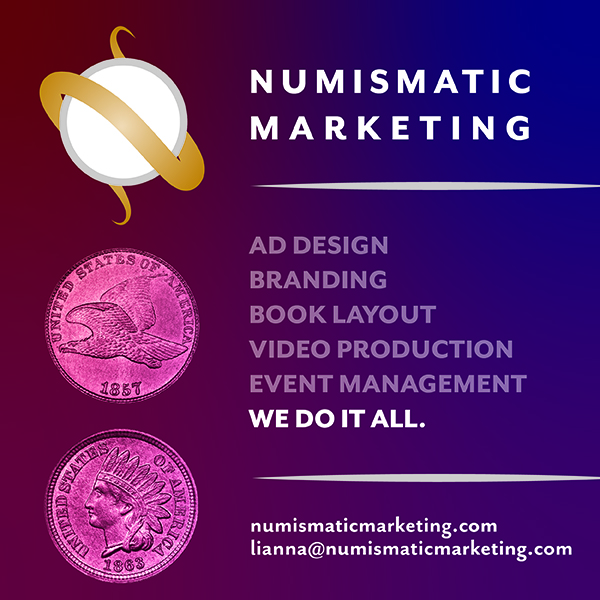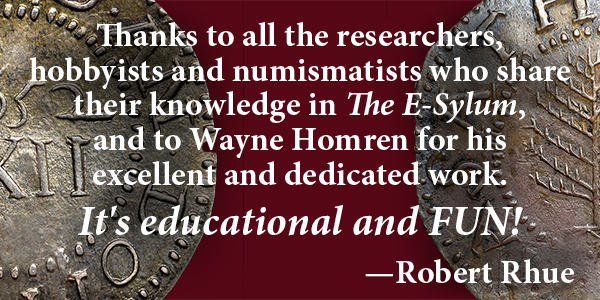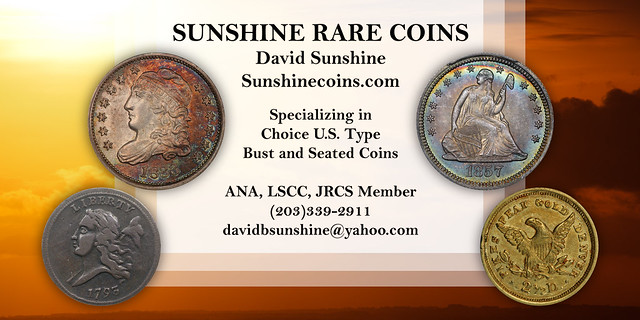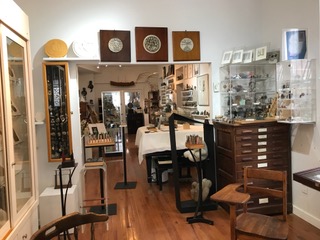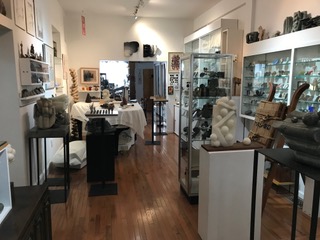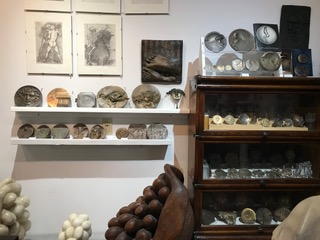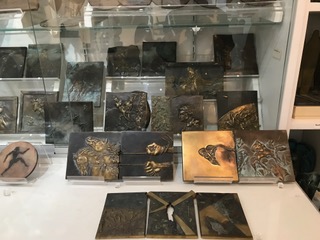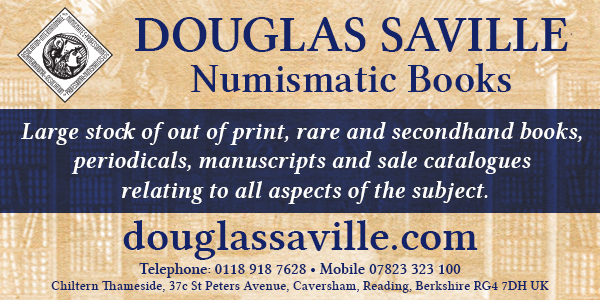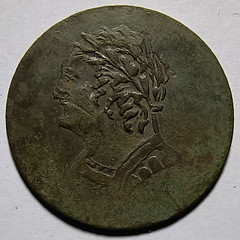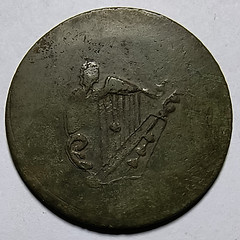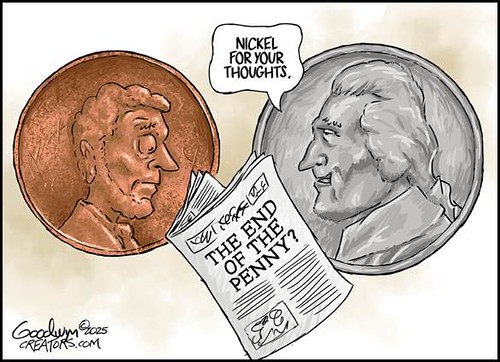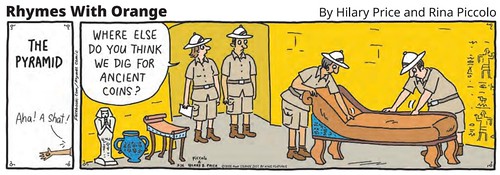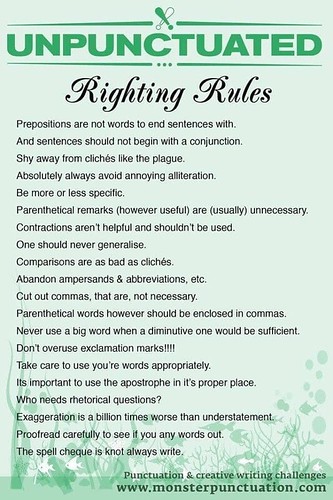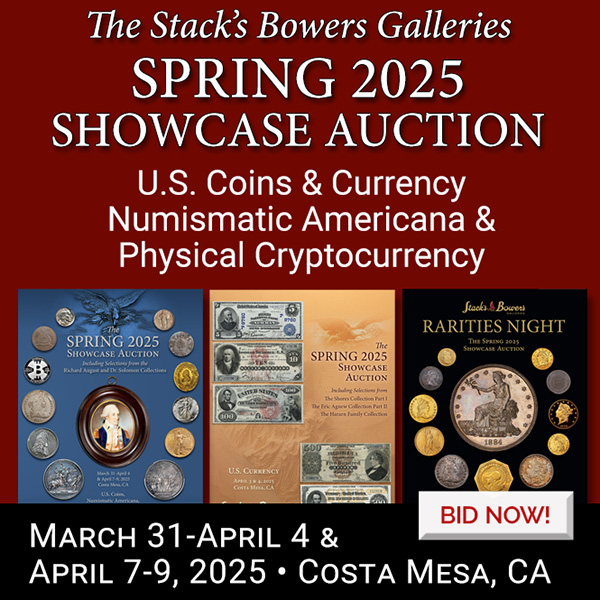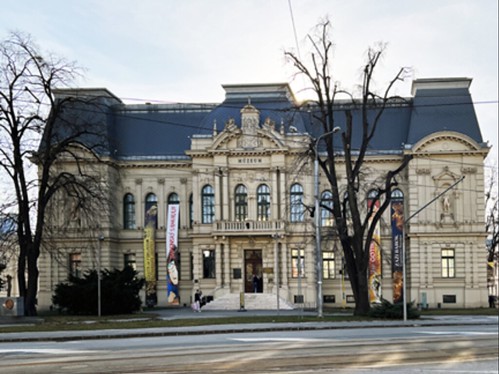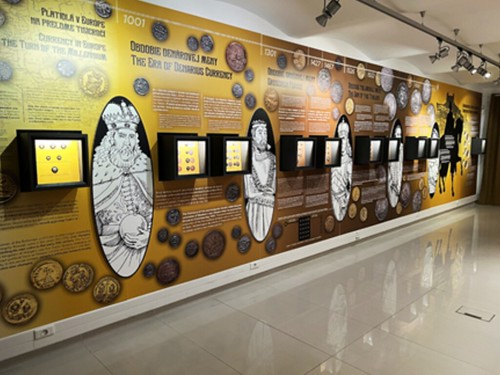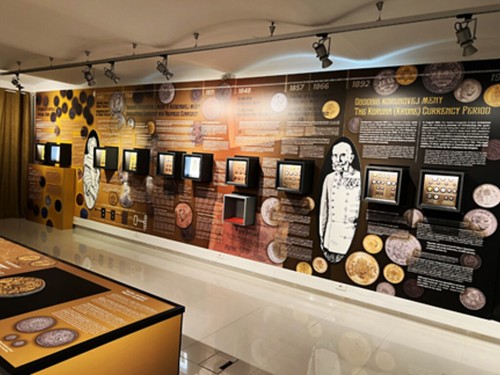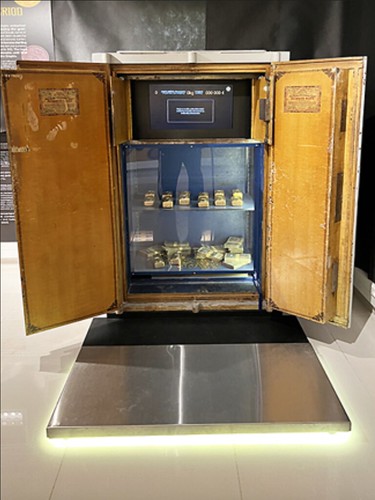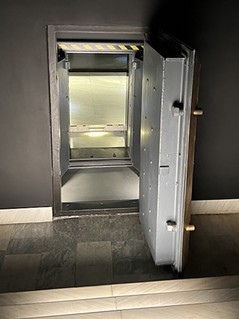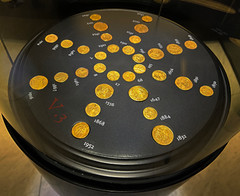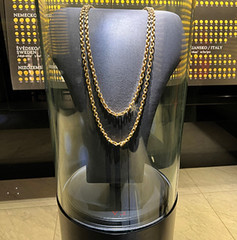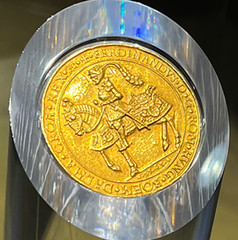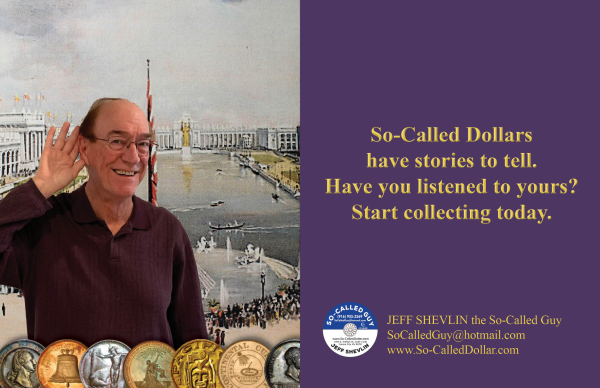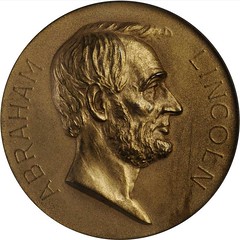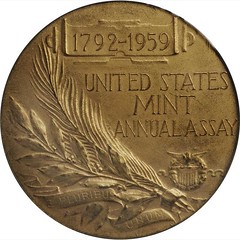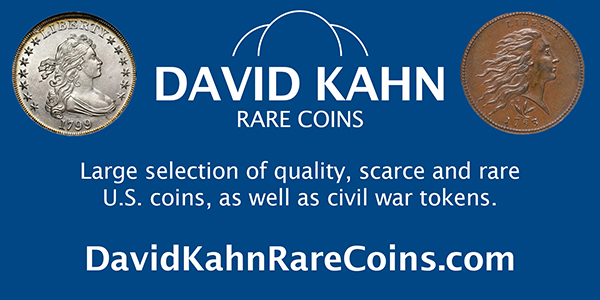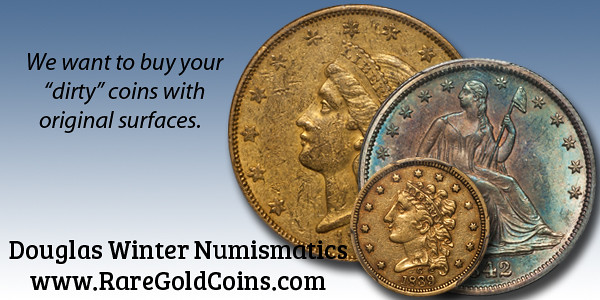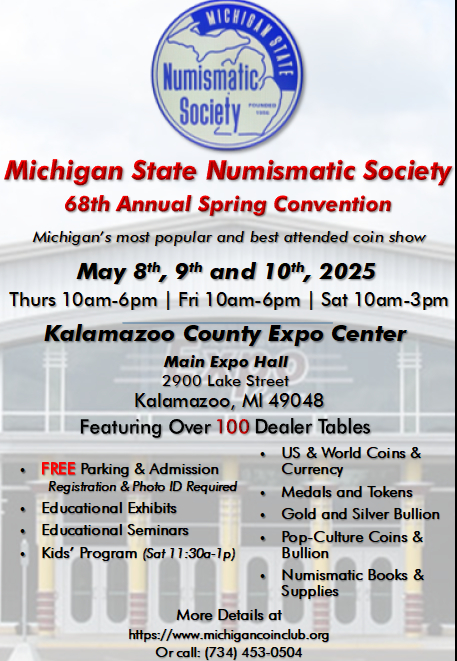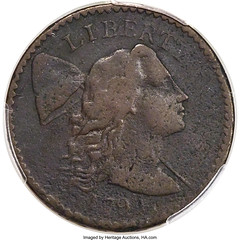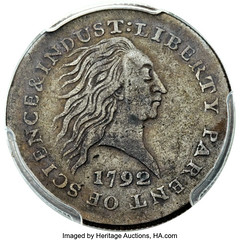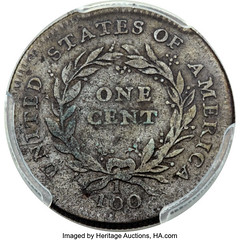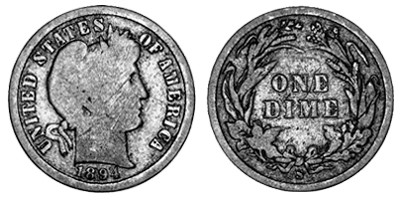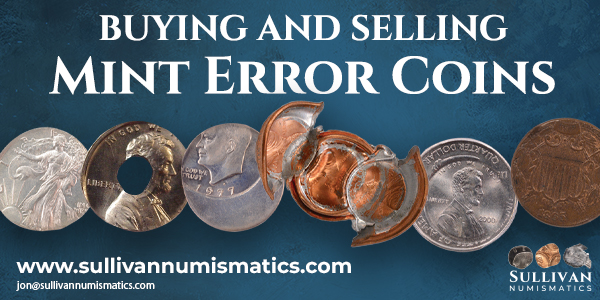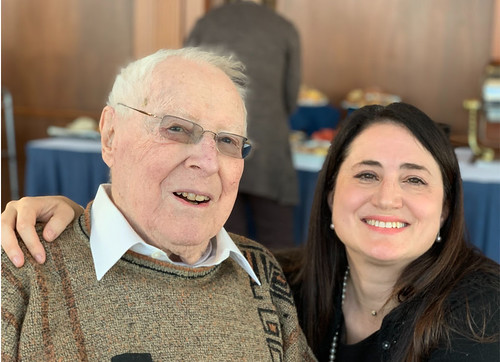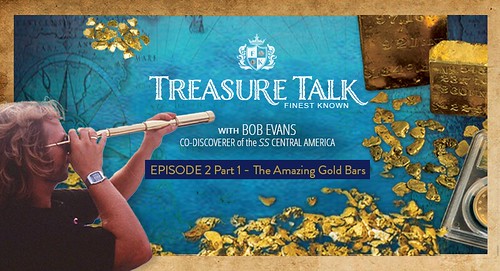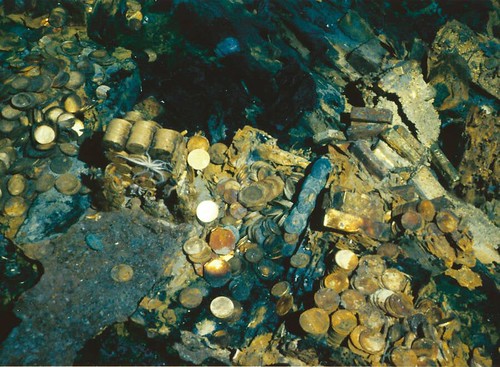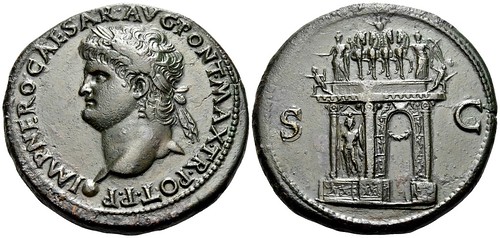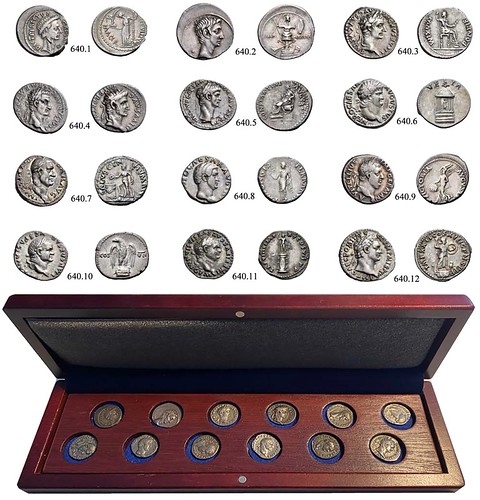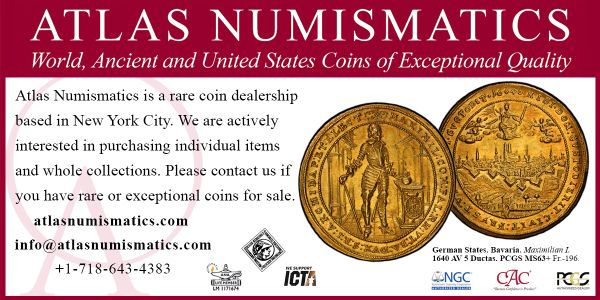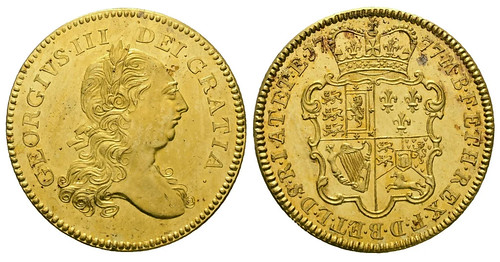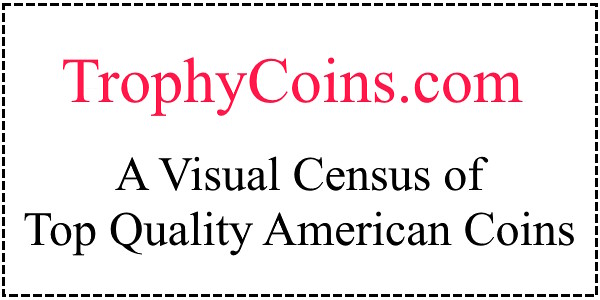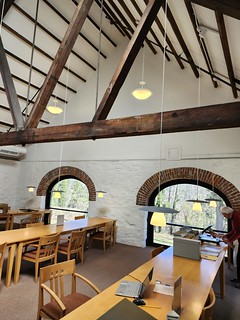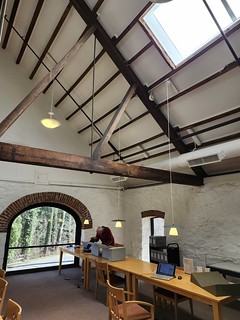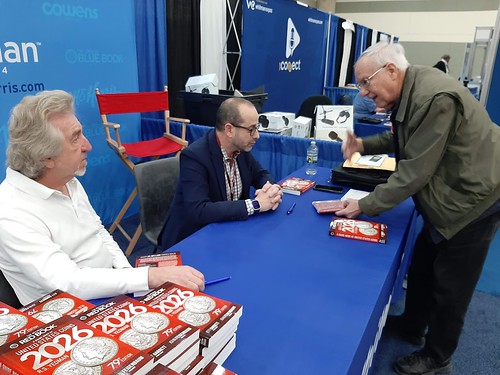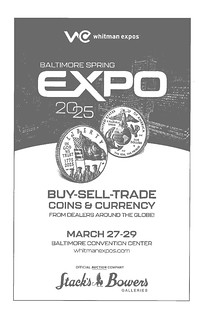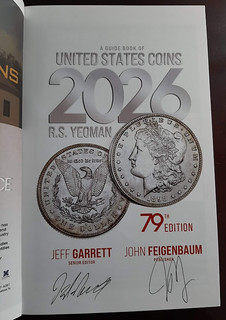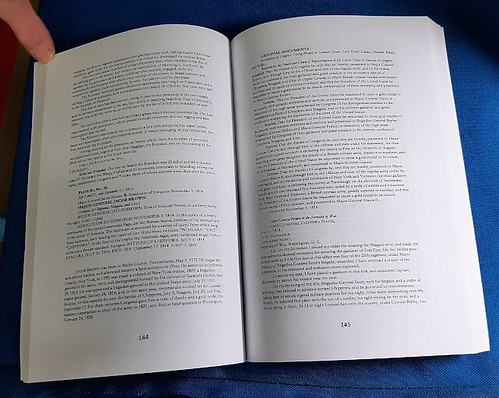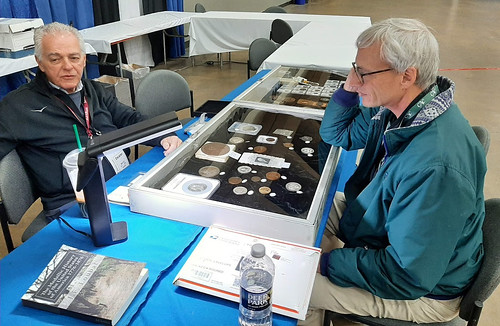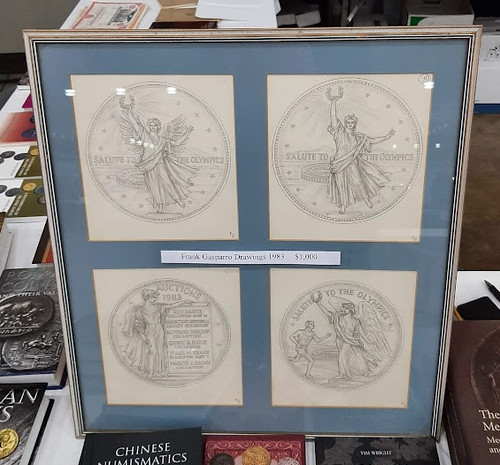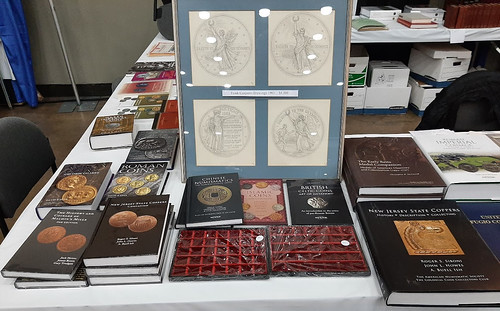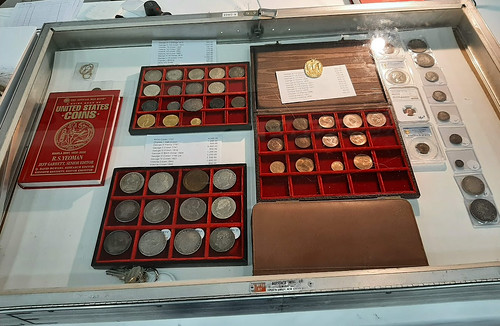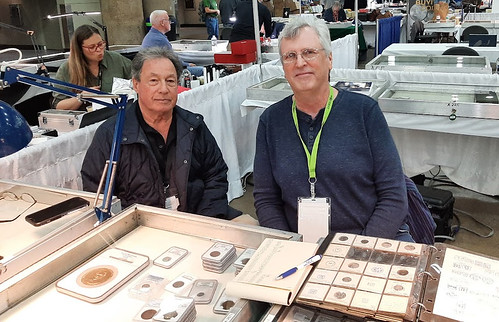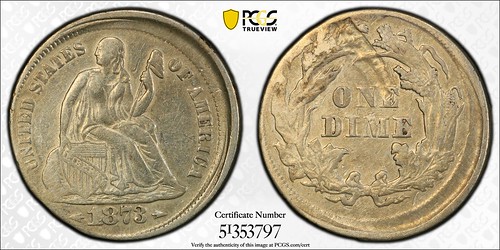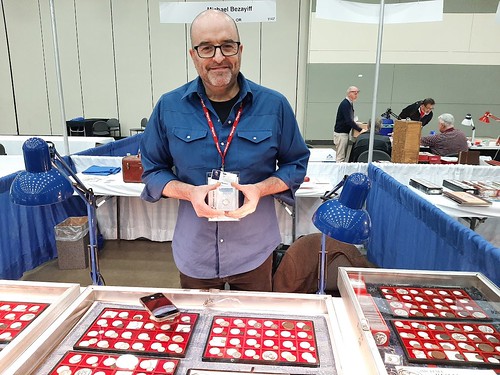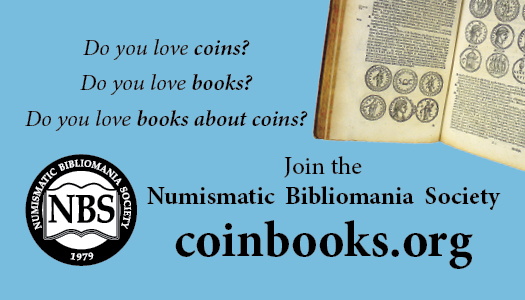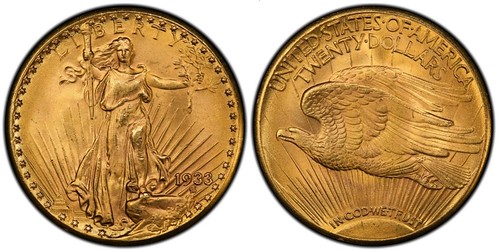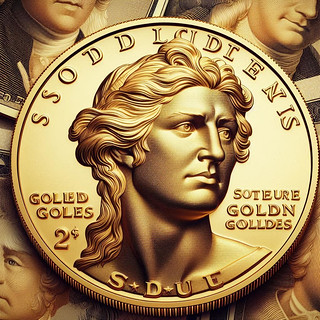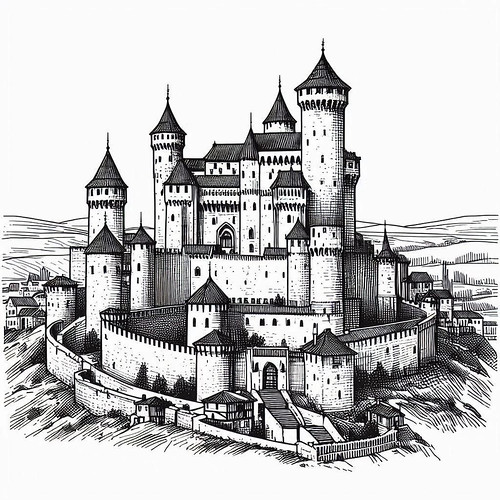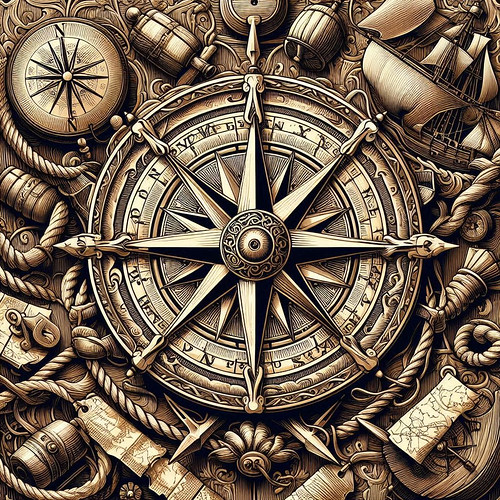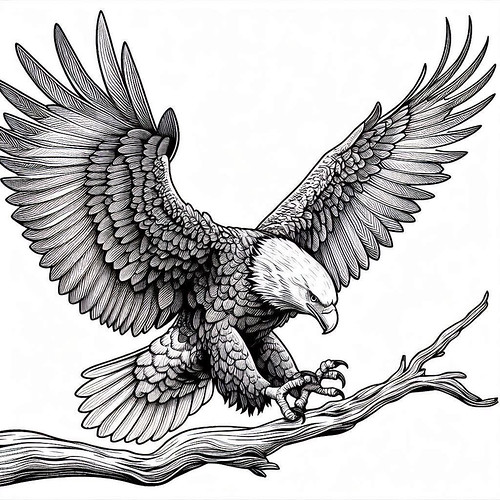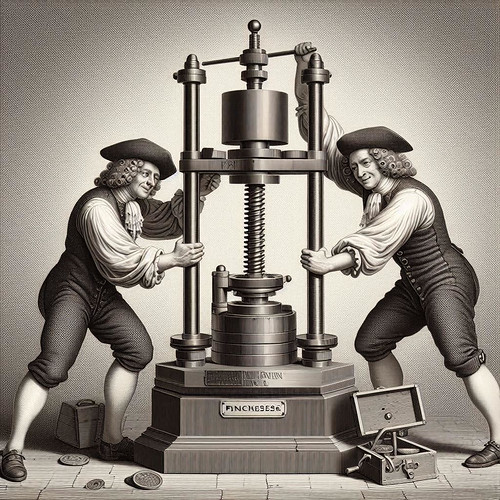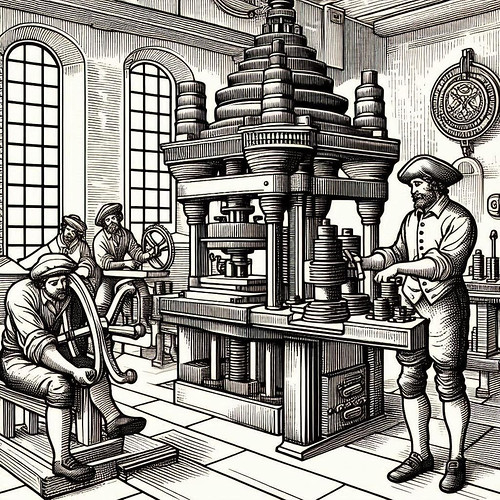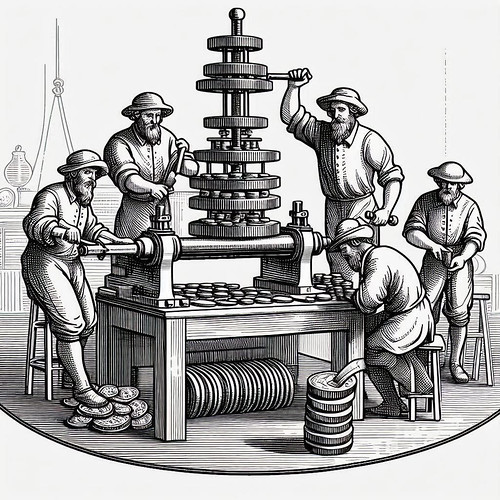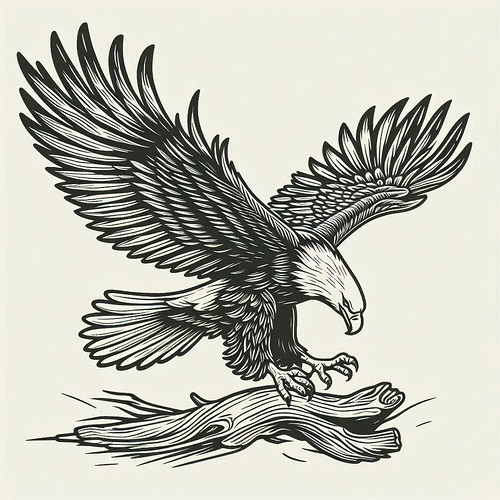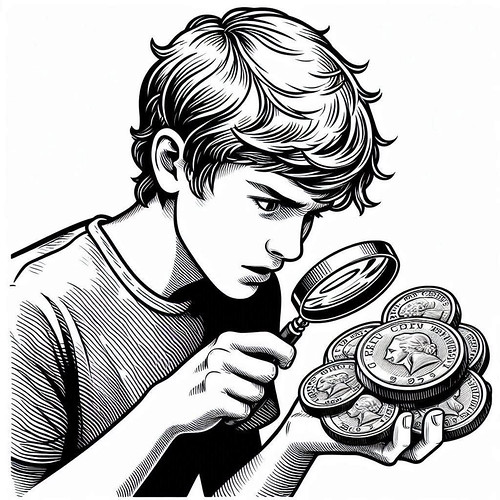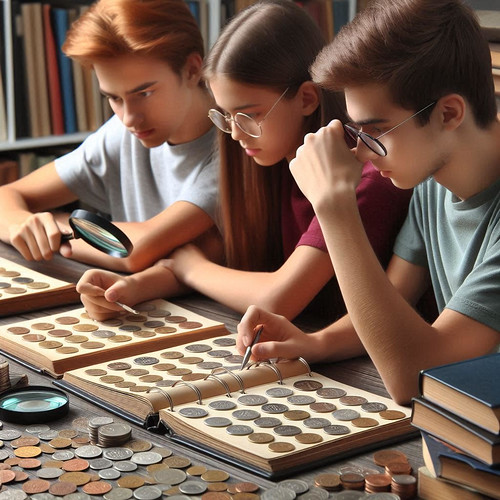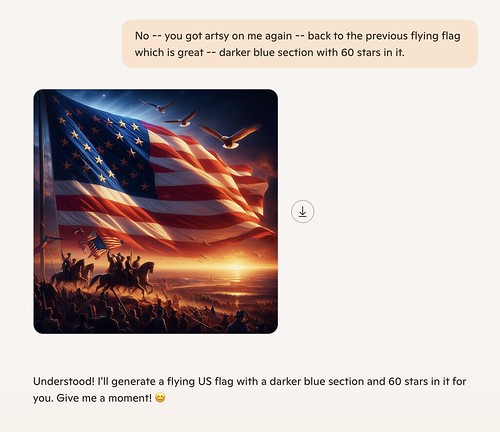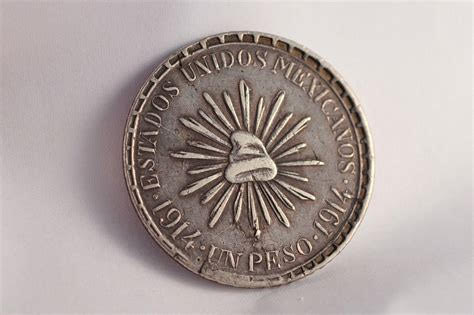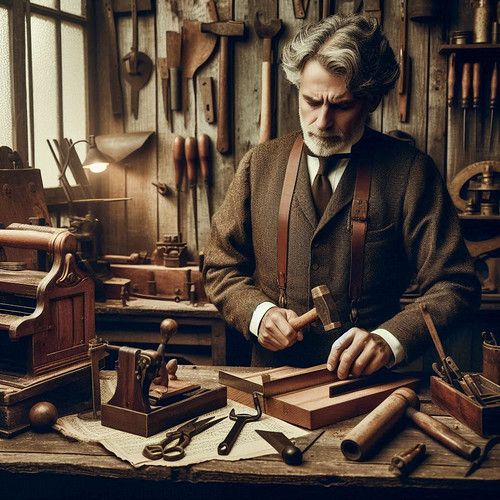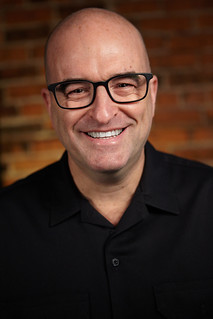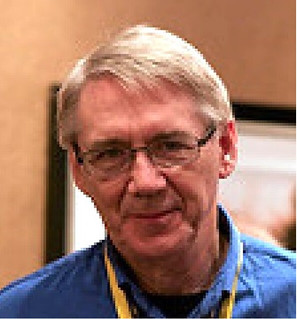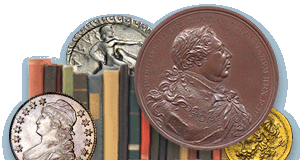
Visit our NBS Sponsors
About UsThe Numismatic Bibliomania Society is a non-profit association devoted to the study and enjoyment of numismatic literature. For more information please see our web site at coinbooks.org SubscriptionsThose wishing to become new E-Sylum subscribers (or wishing to Unsubscribe) can go to the following web page link MembershipThere is a membership application available on the web site Membership Application To join, print the application and return it with your check to the address printed on the application. Print/Digital membership is $40 to addresses in the U.S., and $60 elsewhere. A digital-only membership is available for $25. For those without web access, write to: Jeff Dickerson, Treasurer AsylumFor Asylum mailing address changes and other membership questions, contact Jeff at this email address: treasurer@coinbooks.org SubmissionsTo submit items for publication in The E-Sylum, write to the Editor at this address: whomren@gmail.com BUY THE BOOK BEFORE THE COINSale CalendarWatch here for updates! |
- WAYNE'S WORDS: THE E-SYLUM MARCH 30, 2025
- NEW BOOK: SILVER COINAGE OF THE GUPTA EMPIRE
- NEW ARTICLE: PUERTO RICO'S PROVINCIAL PESOS
- NUMISTA ADDS LITERATURE SECTION
- NEWMAN PORTAL ADDS BOURGEY CATALOGS
- VIDEO: GOLD RUSH BILLS OF EXCHANGE
- 2025 NATIONAL MONEY SHOW EXHIBIT WINNERS
- 2025 ROCKWELL LECTURE: DR. DAVID LEONG
- 2025 ORDERS AND MEDALS SOCIETY CONVENTION
- MEDIALIA GALLERY REOPENS
- NOTES FROM E-SYLUM READERS: MARCH 30, 2025
- THE NUMISMATOURIST VISITS KOSICE
- VOCABULARY TERM: REMODEL, REMODELED
- LINGUISTS ABOLISH OBVERSE AND REVERSE
- EMERGING COINS
- CARL SUBAK COLLECTION OF ROMAN QUINARII
- TREASURE TALK WITH BOB EVANS, EPISODE 2.1
- ANS TO ESTABLISH COLLIER PRIZE
- THE TRAVELLER COLLECTION
- LEN AUGSBURGER'S NUMISMATIC DIARY: MARCH 30, 2025
- WAYNE'S NUMISMATIC DIARY: MARCH 30, 2025
- MINT DIRECTORS DIEHL AND MOY ON BITCOIN
- FORT KNOX GOLD TO BE SOLD!
- THE MARY KAWENA PUKUI DOLLAR
- ON AI-GENERATED COIN IMAGES
- ABOUT THIS ISSUE: MARCH 30, 2025
Content presented in The E-Sylum is not necessarily researched or independently fact-checked, and views expressed do not necessarily represent those of the Numismatic Bibliomania Society.
WAYNE'S WORDS: THE E-SYLUM MARCH 30, 2025
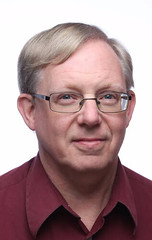 New subscribers this week include:
Tim Currie and
Claire Lobel.
Welcome aboard! We now have 7,256 subscribers.
New subscribers this week include:
Tim Currie and
Claire Lobel.
Welcome aboard! We now have 7,256 subscribers.
Thank you for reading The E-Sylum. If you enjoy it, please send me the email addresses of friends you think may enjoy it as well and I'll send them a subscription. Contact me at whomren@gmail.com anytime regarding your subscription, or questions, comments or suggestions about our content.
This week we open with a new book and an article, a numismatic literature feature for Numista, updates from the Newman Numismatic Portal, club news and more.
Other topics this week include Puerto Rico's provisional pesos, Paris dealer Bourgey, California gold rush bills of exchange, the 2025 Rockwell Lecture, Medialia Gallery, the Carl Subak and Traveller collections, two Baltimore show diaries, the Mary Kawena Pukui dollar, and AI-generated images.
To learn more about the silver coinage of the Gupta Empire, 1967 Canadian Centennial Medallions, 2025 National Money Show exhibit winners, Operations Andreas & Bernhard, the Orders & Medals Society of America, the largest and richest find of gold coins in Slovakia, the Hull-Sewell Pine Tree Shilling hoard, Roman Quinarii, and the Treasure of the One-Eyed Priest, read on. Have a great week, everyone!
Wayne Homren
Editor, The E-Sylum
NEW BOOK: SILVER COINAGE OF THE GUPTA EMPIRE
Ian Todd and Alex Fishman have published a new book on the silver coinage of the Gupta Empire. Congratulations! Here's the announcement. -Editor
The Silver Coinage of the Gupta Empire and Associated States in Western India: Analysis,
classification and illustrated catalogue
Authors: Ian J. Todd and A.M. Fishman
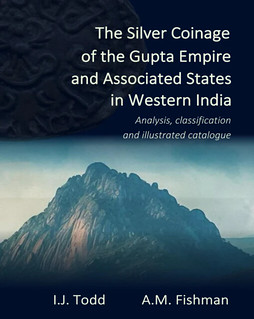 Dealing with the silver coinage and events around the time of the fall of the Western K?atrapa
kingdom in the period 398-415 CE, and in the century that followed, this work comprehensively
catalogues unprecedented integrated coin classifications for – and fresh historical conclusions about –
the Gupta empire and associated states including the Traiku?akas and Kalachuris. It also broadens the
known history of the Western K?atrapas by identifying the coinage of two individuals who succeeded
the kingdom's last great ruler; and through detailed analysis introduces the previously
unknown “Second K?atrapa Kingdom” ruled by a king named Madasena and his sons, and with
coinages formerly misattributed to the Maitrakas of Valabhi and the Western K?atrapas.
Dealing with the silver coinage and events around the time of the fall of the Western K?atrapa
kingdom in the period 398-415 CE, and in the century that followed, this work comprehensively
catalogues unprecedented integrated coin classifications for – and fresh historical conclusions about –
the Gupta empire and associated states including the Traiku?akas and Kalachuris. It also broadens the
known history of the Western K?atrapas by identifying the coinage of two individuals who succeeded
the kingdom's last great ruler; and through detailed analysis introduces the previously
unknown “Second K?atrapa Kingdom” ruled by a king named Madasena and his sons, and with
coinages formerly misattributed to the Maitrakas of Valabhi and the Western K?atrapas.
The 358 page, independently published, book is available in paperback or hardcover at amazon.com and numismall.com.
The Silver Coinage of the Gupta Empire and Associated States in Western India has received favourable recommendations from numerous esteemed numismatists, in particular:
Wilfried Pieper, author of Ancient Indian Coins - A Comprehensive Catalogue:
"Long-awaited, urgently needed! The new landmark publication by Ian Todd and Alexander Fishman on the silver coins of the Gupta kings and their contemporaries – starting with the fall of the last K?atrapas – is a gain in scientific knowledge for historians and numismatists alike, a real reading pleasure, a must-have for each and every collector. Old tracks are re-read and re-evaluated, new coins and new names are presented, loose ends are tied together. The result is an exciting journey through, and a completely new picture of, the political and numismatic history of 5th century India."
Robert Tye, author of Jitals and Early World Coins and Early Weight Standards:
"Another tour de force by Todd and Fishman, names now fixed in the proud annals of independent numismatic scholarship."
Dr. Harry Falk, a noted Indologist, retired professor and Director of the Institute of Indian Philology and Art at the Free University in Berlin:
"The Gupta dynasty initiated a glorious phase in the history of India. Its advances and achievements are reflected in the magnificent coins it produced, and the same coins are an indispensable tool for a correct description of the political development. This catalogue is all-encompassing, regarding the sheer mass of its contents and its possible interpretations alike. This book will be essential for serious historiography for generations to come."
John Deyell, author of Living Without Silver; Treasure, Trade and Tradition; From Mountain Fastness to Coastal Kingdoms; and Lakshmi, Bearer of Riches:
"In times past, the people of peninsular Gujarat were well known for their strong preference for small silver coins. This gave rise to large quantities of carefully-engraved drammas that have attracted the attention of numismatists for many generations now. A great deal of them are well identified and classified, but many others are still subject to considerable debate. Todd and Fishman are to be congratulated for tackling the knottier problems of attribution, and for presenting us a lucid and convincing catalogue that very cogently ties together the long succession of K?atrapa – Gupta – Traiku?aka – K???araja silver drammas into an evolutionary succession. In doing so they have, once again, provided numismatists a rich databank of epigraphic, metrological and metallographic information that should foster future interest, and research, into this interesting series."
Robert Senior, author of Indo-Scythian Coins and History Volumes I-IV and The Coinage of Hermaios and its Imitations Struck by the Scythians:
"It takes exceptional people to interpret the mass of information about sequences, dates, rulers and contemporaries that is uniquely available from the silver coinages of the Guptas and associated states – and then present it in all its complexity in the clearest of drawings, diagrams and illustrations. Todd and Fishman's book is a splendid read, full of new interpretations and ideas which has filled a huge gap in our knowledge and is an achievement of the first order. It will be the standard reference for at least a generation."
For more information, or to order, see:
Todd/Fishman 2025: Hardcover - The Silver Coinage of the Gupta Empire and Associated States in Western India
(https://www.numismall.com/collections/numismatic-literature/products/todd-fishman-2025-hardcover-the-silver-coinage-of-the-gupta-empire-and-associated-states-in-western-india)
The Silver Coinage of the Gupta Empire and Associated States in Western India: Analysis, classification and illustrated catalogue (Hardcover Edition)
(https://www.amazon.com/Silver-Coinage-Empire-Associated-Western/dp/B0F23WYP54/ref=sr_1_1)
NEW ARTICLE: PUERTO RICO'S PROVINCIAL PESOS
Researcher Ángel Navarro published the results of his long-running research on Puerto Rico's Provincial Pesos and Dollars in the 2024 edition of the Numismatic Chronicle published by The Royal Numismatic Society of London. Here's a short excerpt. -Editor
Models for Morgan's proposed Puerto Rican coinage: the 1882 Liberty portrait (left) and the 1890/1 Columbia and Eagle pattern (right). Images courtesy of Heritage Auctions, www.HA.com.
Abstract: This article aims to reconstruct a segment of Puerto Rico's monetary history from the late nineteenth and early twentieth century, focusing on the transition from the Puerto Rican provincial currency (the ‘peso') to the United States dollar after the Spanish American War. Following the conclusion of the conflict, the Puerto Rican currency saw a swift devaluation, leading to its subsequent withdrawal from circulation. This study, which draws on newly discovered archival sources, suggests that US authorities contemplated the creation of a separate coinage for Puerto Rico, which aimed to ease the conversion from the provincial peso to the US dollar.
Introduction
Coins have long been considered as one of a nation's prime sovereign symbols, and for this reason the monetary and economic history of Puerto Rico presents significant difficulties. The island did not establish an official currency until the end of the nineteenth century, and before this time a variety of coins circulated concurrently, each with a unique origin, distinct intrinsic value, questionable legal standing, and local value distinct from its international value. This reliance on foreign currency, combined with protracted currency shortages and constant modifications to the monetary system, created conditions that were more than sufficient to impede the local circulation of goods and the formation of capital. By the 1890s the Spanish authorities had started to contemplate a definite solution to this dilemma.
The provincial peso of Puerto Rico (1895–6)
On 17 August 1895 Queen Regent María Cristina granted the Puerto Rican people the right to use their own currency. The new coin was known as the Puerto Rican provincial peso, and was manufactured under the direction of Don Tomás Castellano y Villarroya, the Minister of Overseas. The Spanish authorities likewise created a currency for the Philippines in return for this same concession. However, due to the outbreak of the War of Independence in 1895, Spain's other remaining Caribbean territory, Cuba, was not granted its own provincial money.
That same year, Antonio Cánovas del Castillo's conservative Spanish cabinet, which included the Minister of Overseas Don Tomás Castellano y Villarroya, sought to address Puerto Rico's financial difficulty. In order to tackle the island's economic problem, he deliberated on three proposals:
- The introduction of the gold standard, with gold coins in circulation;
- The introduction of the Spanish monetary system in Puerto Rico, using Spanish silver coins;
- The creation of an exclusive currency for Puerto Rico, whose monetary unit (1 peso) had the same silver weight and fineness as the Spanish 5 pesetas piece, and had a distinctive emblematic design.
While the gold standard project was considered ideal, it was not considered viable at that time for two main reasons. Firstly, it was thought to be unreasonably costly for Spain to place its colony on a gold standard when it could not afford to do so. Secondly, if the gold standard was introduced to Puerto Rico, it was suspected that the gold coins that were in circulation would immediately disappear, depriving the island of its currency.
Many people were sceptical of the plan to make Puerto Rico's currency identical to Spain's. The fundamental issue was that, if Mexican pesos were to replace Spanish currency, the balance of payments would mean that Spanish funds would leave Puerto Rico and be sent back to Spain and, by extension, to other countries via Spain. There would have been a catastrophic scarcity of currency in circulation if this had happened in Puerto Rico.
The third option was chosen, leading to the creation of a unique currency for Puerto Rico known as the Provincial Currency. -Editor
Ángel adds:
"I began the research with Dr. Richard Doty almost two decades ago, and just recently I finally expanded it thanks to Mr. Roger W. Burdette, Len Augsburger and a grant from the Eric P. Newman Numismatic Education Society."
Roger adds:
"The 1891-dated pattern was also used on the 1906 experimental double eagle to test edge lettering for the Saint-Gaudens double eagle patterns."
The article also illustrates design sketches for the proposed Puerto Rican coinage. Images courtesy of the National Numismatics Collection, National Museum of American History, Smithsonian Institution. -Editor
NUMISTA ADDS LITERATURE SECTION
Founded by Xavier Rogé in 2007, Numista is one of the oldest numismatic sites on the internet. Christopher Blackington and Dzmitry Huletski passed along information about the new Numista numismatic literature section. Thank you! This could prove very useful, and I encourage readers to consider contributing. NOTE: these are bibliographic listings, not digital versions of books. Currently some 4205 books and periodicals, 328 articles and 2,462 authors and editors are listed. -Editor
Christopher Blackington writes:
"E-Sylum readers may be interested to know that Numista is now including numismatic literature in their database. Users can also log the books they have in their libraries.
"I think this a fantastic addition to Numista and I've already added a few volumes to the catalog myself!"
Numista, renowned for its extensive global database of over 800k varieties of coins, banknotes, tokens, and medals, has recently launched a dedicated Literature section. This new addition includes numismatic books, journals, and scholarly articles, expanding its offerings to serve researchers and enthusiasts.
Key Features
The literature section features a searchable database of publications covering various aspects of numismatics, from historical catalogues to academic papers. Operated collaboratively, community members can contribute new entries, ensuring a comprehensive resource. Each entry provides essential details such as title, author bios, publishers, publication year, and edition.
Entries are categorized by topic, like coins of the United States or 19th-century French medals, with download links available where possible. Numista invites numismatic authors to keep track of your bibliography in our database!
Innovative Integration
An innovative integration with Numista's coin catalogue allows seamless navigation between coin references and related literary sources. Additionally, users can manage their personal collections through "My Bookshelf" facilitating easy access to their stored books and journals.
This expansion underscores Numista's commitment to advancing numismatic knowledge, enriching its platform for global numismatic research and dissemination of knowledge.
I like the inclusion of book cover images. The visuals make for a pleasant interface. -Editor
While implementation is spotty given the crowdsourced nature of the site, the integration of individual numismatic item entries with the associated catalog is a nice feature. Here's an example of 1967 Canadian Centennial Medallions on the site. -Editor
To visit the Numista numismatic literature section, see:
Numismatic literature
(https://en.numista.com/literature/)
Fore the Numista homepage, see:
https://en.numista.com/
To read a CoinsWeekly article, see:
Numista Now Has a New Literature Section
(https://new.coinsweekly.com/news-en/numista-now-has-a-new-literature-section/)
NEWMAN PORTAL ADDS BOURGEY CATALOGS
The latest additions to the Newman Numismatic Portal are catalogs of the Paris dealer Bourgey. Project Coordinator Len Augsburger provided the following report. -Editor
Newman Portal Adds Bourgey Catalogs
Can you think of a numismatic firm that has maintained the same address for over a century? Remarkably, the Paris dealer Bourgey has held forth at 7 rue Druout since 1907. The business was founded by Étienne Bourgey (1864-1943) in 1895. Among other accomplishments, Étienne cataloged the 1922 Arras hoard, an important group of Roman coins that most notably included gold medallions. He was succeeded by his son Émile (1914-1993), a co-founder of IAPN, and today the firm is operated by Sabine Bourgey.
Newman Portal has recently added 94 auction sale catalogs from this firm, most of which were scanned at American Numismatic Society in New York. This is a useful resource for ancient numismatics, as John Spring's Ancient Coin Auction Catalogues 1880-1980 includes Bourgey catalogs as nos. 9-59. Newman Portal acknowledges Sabine Bourgey for extending permission to present these catalogs with full view.
Link to Bourgey catalogs on Newman Portal:
https://nnp.wustl.edu/library/auctioncompanydetail/515406?Year=1926&displayAmt=50
Link to Sabine Bourgey Numismatique:
https://sabinebourgey.com/
THE BOOK BAZARRE
VIDEO: GOLD RUSH BILLS OF EXCHANGE
The David Lisot Video Library on the Newman Numismatic Portal can be found at:
https://nnp.wustl.edu/library/multimediadetail/522852
We highlight one of his videos each week in The E-Sylum. Here's one from 2009 with Michael Wehner speaking about California Gold Rush Bills of Exchange. -Editor
Sundman Lecture Series Michael Wehner Many a miner left a sweet heart, wife or parents back east to come to California seeking his fortune in the Gold Rush of 1849. By the early 1850s these miners could purchase "Bills of Exchange" to guarantee that riches gathered would make it back to loved ones safely. This presentation explores early banking in San Francisco and the necessities of exchange services.
Dr. Michael F. Wehner is the past president and current bulletin editor of the Pacific Coast Numismatic Society. He is currently on the Board of Governors of the California State Numismatic Association and is the chairman of the annual show of the Western States Token Society. He has also designed medals as well as served as president for the San Francisco Coin Club. He is a frequent speaker at numismatic events in California and has written numerous articles in several publications including The Numismatist, The Brasher, The Journal of the Token and Medal Society and others.
In this video you will see and learn:
- Story of the California Gold Rush
- Why bills of exchange were used
- Bank failures and how they affected the economy
- Issuers of notes and their stories including James King of William, Adams Company, Page, Bacon & Co., Drexel, Wells, Fargo & Co and others
- Examples of the different note issues
Speaker(s): Michael Wehner.
Michael adds:
"It was an honor to speak at the Sundman lectures. I have acquired many different banks since then. I need to update the paper ..."
To watch the complete video, see:
California Gold Rush Bills of Exchange
(https://www.youtube.com/watch?v=qEX-2fo5Aaw)
California Gold Rush Bills of Exchange
(https://nnp.wustl.edu/library/book/557322)
2025 NATIONAL MONEY SHOW EXHIBIT WINNERS
The following ANA Press Release announces the exhibit winners from the 2025 National Money Show. Also, Paul Hybert passed along an online guide to the Collector Exhibit Area from this show, grouped by Exhibit Class, available at: http://www.chicagocoinclub.org/events/2025/ananms/ex/all_by_cl.html. Visit this page to help you remember the exhibits you saw in 2025. -Garrett
The American Numismatic Association (ANA) presented 24 competitive exhibit awards at the 2025 Atlanta National Money Show®. Winners were announced at the Exhibit Awards Presentation & Reception on Saturday, March 1.
Michael Shutterly received the Steven J. D'Ipolito Award for Excellence in Numismatic Exhibiting (best of show) for his exhibit, "It's Elementary!" The second place D'Ipolito Award was also presented to Shutterly for "Heavenly Gold." Third place was awarded to Mack Martin for his exhibit "Georgia's Reconstruction Bonds."
The Radford Stearns Memorial Award for People's Choice, determined by votes from convention attendees, was presented to Jeffrey Rosinia for "A Numismatic Taste of Collecting Coca-Cola."
The theme for National Coin Week this year is "Iconic Change: Pop Culture & Coins Unite!" National Coin Week exhibits are intended to be suitable for display in libraries and schools, so there is a $250 limit on the value of the materials in this competition. The National Coin Week Award was presented to Gary Dobbins for "Pop! Goes the Music." He will receive a full scholarship to a future ANA Summer Seminar, an award endowed by John Albanese. Second place in this category was awarded to Kathryn Rosinia for "Flower Fairy Coins." Third place was earned by Jeffrey Rosinia for "Berghoff Waiter Tokens."
Radford Stearns Memorial Awards for Achievement in Exhibiting were also presented in six classes. This year, 25 competitive exhibits were displayed in the collector exhibits area by 17 exhibitors. Class winners are as follows:
Class 1: History and Politics (historical or political events)
- First place: Simcha Kuritzky, "Give Me That Old-Time Alphabet! Paleo-Hebrew on Modern Israel Numismatics."
- Second place: Josh Black, "90% Silver, 100% History: The Coins and Sales of the Carson City Morgan Dollars in the GSA Hoard."
- Third place: David Crenshaw, "Honoring Valor: The National Purple Heart Hall of Honor 2022 Colorized Silver Dollar and Legacy of James Paul 'Hank' Heinold."
Class 2: Economics (monetary and financial systems or economic events, such as panics and inflations)
- First place: Mack Martin, "Georgia's Reconstruction Bonds."
- Second place: Chris Coulter, "The Forgotten Story of Georgia's Civil War Bills of Exchange."
- Third place: Simcha Kuritzky, "Branch Davidian Paper Money."
Class 3: Geography (natural or cultural assets, the distribution of populations, or exploration)
- First place: Simcha Laib Kuritzky, "Vermont's Catamount."
- Second place: Judy Dobbins, "Wolfgang Amadeus Mozart: The Prodigy ... The Genius ... The Legend."
- Third place: Richard Jozefiak, "Official Alaska Statehood Medals 1959 & 2009."
Class 4: Common Elements (material linked by common themes and designs, such as Queen Elizabeth II, elephants, bridges, or world's fairs)
- First place: Michael T. Shutterly, "Heavenly Gold."
- Second place: Jeffrey Rosinia, "A Taste of Collecting Coca-Cola."
- Third place: Kathryn Rosinia, "Flower Fairy Coins."
Class 5: The Arts (any aspect of fine or applied arts)
- First place: Simcha Kuritzky, "Israel & Currency: Her Innovative Approach to the Question of Idolatrous Money."
- Second place: John Domurat, "Heraldic Art Medals: Regular and Occasional Silver Issues, 1959-1978."
- Third place: Jeffrey Rosinia, "Liberty Centennial Gold."
Class 6: Science (theoretical or applied science, including the technology of manufacturing numismatic items)
- First place: Michael T. Shutterly, "It's Elementary!"
- Second place: Dennis Schafluetzel, "Bank of Chattanooga Civil War Error Note Types."
- Third place: No exhibit.
In addition to the D'Ippolito and Stearns medals that winning exhibits receive, there are the following numismatic prizes:
- Class Awards: First place, 1/10 ounce American Eagle; second place, proof American Silver Eagle; third place, bullion American Silver Eagle.
- National Coin Week Awards: First place, Summer Seminar scholarship; second place, Proof American Silver Eagle; third, bullion American Silver Eagle.
- Best-of-Show Awards: First place, 1/2 ounce American Eagle; second place, 1/4 ounce American Eagle; third place, 1/10 ounce American Eagle.
The application deadline for exhibiting at the 2025 ANA World's Fair of Money®, which will be held August 19-23 in Oklahoma City, OK, is June 1. For an application form or more information, phone (719) 482-9849; email exhibits@money.org; or visit money.org/convention-exhibits.
2025 ROCKWELL LECTURE: DR. DAVID LEONG
John Ferreri passed along this announcement for the next Boston-area lecture in honor of Thomas P. Rockwell. Thanks. -Editor
Monday, April 7, 2025, at 7:30 p.m.
Boston Numismatic Society, Currency Club of New England, and Collectors Club of Boston
We are pleased to announce that this year's speaker is Dr. David Leong who will be giving a talk on “Operations Andreas & Bernhard". This fast-moving talk is designed to appeal to anyone with an interest in either banknotes, WWII, military history, counterfeiting, the forced labor of Jewish concentration camp prisoners to produce counterfeits for the Reich, or the production of banknotes. Designed to appeal to Individuals with no knowledge of the history of the Germany counterfeiting operations during WWII, to individuals that know the basic history though those well versed in the history and the banknotes.
The talk will start with the Germans first attempt to counterfeit British Pound notes under Operation Andreas. Before moving to the more famous Operation Bernhard, which was the basis for the 2007 Oscar winning movie The Counterfeiters. While those familiar with Operation Bernhard know of the printing operation at Sachsenhausen, most know nothing of the paper used to produce the notes. Details on the printing operations along with paper production will be provided along with basic diagnostics to determine Operation Bernhard notes from genuine British notes.
The presentation will include new information not previously known from documents provided by the Sachsenhausen, Hahnemühle, and research performed by the speaker on the manufacturing of the Bernhard notes and the search for Operation Andreas notes.
Several copies of the book Forging Secrets: Faces and Facts Inside the Nazi Operation Bernhard will be available for purchase. If you would like to reserve a copy, please contact the speaker before the talk.
Dr. David Leong, like most, started collecting as a child with interest in Lincoln and Indian Head cents which took a hiatus during college. While traveling internationally in the 1990's, his interest in numismatics was rekindled along with a switch to banknotes due to their intricate and colorful designs. In 1999, David became a part-time dealer in world paper money which continues today. Attending major shows such as Maastricht, ANA, and FUN. David is the long-time president of the Currency Club of New England. Other organizational affiliations include The International Banknote Society (IBNS), ANA, and FUN. In addition, David is current Governor of the Professional Currency Dealer Association (PCDA). While there has always been a general interest in Operation Bernhard notes, David started researching it in depth more than 10 years ago. With each new piece of information learned, the drive to learn more continued.
Please join us at the New Light Korean Church 730 Main St (Rt.20) Waltham for an informative and enjoyable evening. The program will commence at 7:30 pm, the building will be open to socialize at 6:30 pm. In addition to the church, there should be sufficient on-street parking and across the street at the Waltham Library (after 6 PM). For further information please contact William Harkins at williamharkins@comcast.net.
John adds:
"Once a year the three clubs mentioned together sponsor the Rockwell Memorial Lecture in honor of Thomas P. Rockwell, a member and mover in each of these three clubs. Tom passed away in 2012 at the age of 95. The three clubs sponsor this "Lecture" in his memory. This lecture is open to all who wish to attend."
2025 ORDERS AND MEDALS SOCIETY CONVENTION
Kevin Beyer of the Orders and Medals Society of America submitted this press release about the group's 2025 convention. -Editor
 The Orders & Medals Society of America will celebrate its 75th Anniversary at a convention held in Kansas City, Missouri from Thursday, July 31 until Sunday, August 3, 2025. OMSA's annual convention moves around the country, enabling regional members the opportunity of attending without traveling long distances. This year's centralized location is intended to attract many members and interested collectors.
The Orders & Medals Society of America will celebrate its 75th Anniversary at a convention held in Kansas City, Missouri from Thursday, July 31 until Sunday, August 3, 2025. OMSA's annual convention moves around the country, enabling regional members the opportunity of attending without traveling long distances. This year's centralized location is intended to attract many members and interested collectors.
Members collect, research, and preserve military and civilian orders, awards, and medals, often collectively referred to as "decorations." These items of interest include American and international medals of all types, such as orders of knighthood, decorations for gallantry or distinguished service, and medals for various types of service. Most of these awards can be worn by the recipient, typically on a uniform. However, non-portable medals, known as table medals, are also highly sought after by collectors. Once acquired, researching the history behind awarded medals becomes an essential aspect of the hobby. This research adds significant value, as uncovering the fascinating stories surrounding the medals and their recipients is an enjoyable and rewarding experience.
Benefits of attending:
- See items not seen elsewhere and hear the stories that go with them
- Meet fellow collectors/dealers in person
- Learn from exhibits, seminars, live networking
- Spend quality time with people than incidental interaction at shows
- Advanced and novice collectors can make and maintain long lasting friendships
Attendance is open to registered members throughout the event. Non-registered members and the general public may attend for free on Saturday. The member registration fee of $175 gives access to the convention floor for the three-day bourse and exhibits, two days of seminars, a welcome reception and a banquet featuring a guest speaker and Society awards.
The convention will be held at the Hilton Kansas City Airport, 8801 North West 112th Street, Kansas City, MO. The convention bourse floor and exhibits will be open to non-registered OMSA members and the general public one day only, Saturday, August 2, 2025, from 9am to 5pm. Those interested in learning about medal collecting are cordially and enthusiastically invited. For more information about OMSA and the convention, see https://www.omsa.org.
MEDIALIA GALLERY REOPENS
Great news! Mashiko has completed the move of her Medialia Gallery from Manhattan to nearby Jersey City. Here's the announcement and some images of the gallery and current exhibits. -Editor
medialia@medialiagallery.com
Directions to Medialia's new location
is available for appointment visitors.
Medialia specializes in showing international artists
• Art medals • Book-art • Movable • Wearable
THE FOURTH INTERNATIONAL MEDALLIC ART COMPETITION
FOR EMERGING ARTISTS
AWARDED WORKS
•First Prize
The Withington Award: BALANCE by Francesca Muscianesi (Italy)
•Second Prize
The Simpson Award: EQUILIBRIO by Armando Zelinotti (Italy)
•Third Prize
The Pollack Award for American Artist: HERCULES LIGHTNING BOLT SYMBOL
by Ulah Fargo
New Approach Innovative use of Technique/Material Award: UNITY
by Denilin (Bulgaria)
Medialia Innovative use of Technique/Material Award: KESSLER SYNDROME II
by Magdalena Golaszewska (Poland)
•Collector's Purchase Awards
Sponsored by Kakitsubo, Lannin, Miller, Rezak, Scarinci and Scher
COLLECTION OF MEDALS from NEW JERSEY COLLECTORS
• MEDAL OF FAMOUS WRITERS from Scott Miller
•PORTRAITS OF THEODOR MOMMSEN from Nathan Elkins
•A COLLECTION OF PORTRAITS from Mashiko
I encourage readers to schedule a visit sometime. -Editor
For more information, see:
https://www.medialiagallery.com/
To read the earlier E-Sylum articles, see:
WAYNE'S NUMISMATIC DIARY: APRIL 21, 2019
(https://www.coinbooks.org/v22/esylum_v22n16a25.html)
MEDIALIA GALLERY VISIT
(https://www.coinbooks.org/v22/esylum_v22n16a26.html)
MEDIALIA GALLERY IS MOVING
(https://www.coinbooks.org/v24/esylum_v24n46a14.html)
MEDIALIA GALLERY CLOSING
(https://www.coinbooks.org/v25/esylum_v25n05a13.html)
NOTES FROM E-SYLUM READERS: MARCH 30, 2025
Publishers of Numismatic Book Reprints
Inspired by the recent discussion of Bonanza Books, last week I asked, "Who were the other major publishers of numismatic book reprints?"
Pete Smith responded with Quarterman Publications and Sanford Durst. I was also thinking of Augustus Kelley, who reprinted economic classics. I have a few on my shelves, like the reprint of Phillips on colonial currency. Can anyone think of others? -Editor
To read the earlier E-Sylum article, see:
MORE ON BONANZA BOOKS
(https://www.coinbooks.org/v28/esylum_v28n12a05.html)
Token Help Sought
Website visitor Tim Currie asks about an undated Canadian Bust and Harp "blacksmith" token. Can anyone help? -Editor
I came across your site online as I was searching for information about a token I found metal detecting about a week ago, here in Ontario, Canada. Of course, I have lots of questions about it, and there does not seem to be a lot of information out there in the numismatic communities. So I am hoping that you could help me with a few things, especially as it seems that the token is indeed quite rare.
First of all, I have taken it to a coin dealer in town, and the person I talked to almost dismissed it because of its green patina. However, other sources indicate that environmental, natural patina on an old coin does not necessarily decrease its value. What do you think? I have included photos of the token. The detail is very good, although the bust has some (old) scratches, and there is a bit of corrosion on the harp side. The soil in which it was found was well drained, so I believe that helped maintain the integrity of the metal.
The shop did a test on the token, and I was told it was made of 94% copper and 6% zinc. The employee's opinion was that it should be regarded as the copper version (BL-35A1), because the zinc content was so low. He thought that the brass version (BL-35A2) would have a much higher percentage of zinc. On the Numista site, an example is listed, with a value of $495 shown for VG condition. The only other example I could find was shown by Heritage Auctions, but no value was indicated for that token.
There are a couple of features on this token which I have not found in the descriptions I've found to this point. First of all, it has a die rotation of 180 degrees (up/down), and the sites mentioned above do not indicate that any known examples have that rotation. Secondly, the reverse harp side is double stamped around the harp on the left and above. I'm not sure if these factors have an effect on the value of the token. It has a mass of 5.1 g, and a diameter of about 27 mm.
So if you or someone you know can provide any assistance to help me discern the rarity, condition, and possible value of this token (not that I am planning on selling it), I would be very appreciative! I'm really just pleased and excited that I could save a little history and bring it back into the light of day."
I passed this along to dealer Jacob Lipson in Ottawa, who writes:
"Looks like BL-35A to me (Breton-1012, Wood-113). The copper and brass variants, as well as known rotations listed in the standard reference in these could very well be dubious or wrong. The Partrick example is listed as being in coin alignment, too. A quick search through iCollector for BL-32A2 shows eight auction appearances that may help.
"Nice find!"
Thoughts, readers? Thank you. -Editor
Coincraft is Hiring
Coincraft in London is hiring. Richard Lobel passed along this description of the opening. -Editor
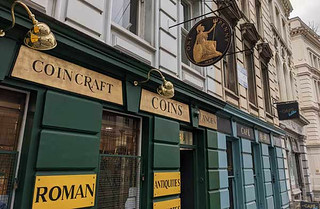 Do you like History? Do you like meeting people?
Do you like History? Do you like meeting people?
Then this may be the job for you!
Coincraft, Britain's Coin Shop is looking for someone to join their small, friendly sales team at their flagship shop in Central London.
We are centrally located just across the street from the British Museum in Bloomsbury. We only deal with collectors we DO NOT sell anything for investment nor do we deal in gold bullion. We have been here for the past 48 years and many consider us the oldest coin shop in the country. Our shop is famous both for the range of items on offer and our friendly staff that is ready to help collectors. You will be able to call on one of the largest and varied stocks in the country to back you up. Whether dealing with specialist collectors or newcomers to collecting, we pride ourselves on providing the best service.
This is a full-time job, Monday to Fridays, 9.30 am to 5.00pm and would suit someone who is enthusiastic and who would enjoy helping collectors, both new and established, who visit our shop. Knowledge of numismatics is helpful but not essential
If you are interested in joining our team, please contact accounts@coincraft.com with your CV for further details.
To read an earlier E-Sylum article, see:
SUBSCRIBER PROFILE: RICHARD LOBEL OF COINCRAFT
(https://www.coinbooks.org/v25/esylum_v25n12a17.html)
Proof Trump Inaugural Medals
Jeff Kelley writes:
"I saw this Coin World article on Trump inaugural medals. Still no sign of them actually being available for sale, though....
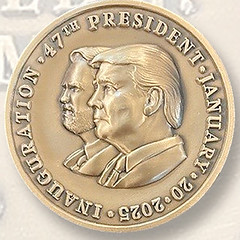 "I'll be interested to see how the proof medals look. Based on an article about Medalcraft Mint that I read several years ago, they use a particular process - "splash minting" if I recall the term correctly - whereby the medals are minted without a collar and then the edge ground down to size. Such an intensive finishing process seems incompatible with a proof finish."
"I'll be interested to see how the proof medals look. Based on an article about Medalcraft Mint that I read several years ago, they use a particular process - "splash minting" if I recall the term correctly - whereby the medals are minted without a collar and then the edge ground down to size. Such an intensive finishing process seems incompatible with a proof finish."
To read the complete article, see:
Bronze and silver inaugural medals being made for sale
(https://www.coinworld.com/news/us-coins/bronze-and-silver-inaugural-medals-being-made-for-sale)
To read the earlier E-Sylum article, see:
2025 TRUMP OFFICIAL INAUGURAL MEDAL
(https://www.coinbooks.org/v28/esylum_v28n09a30.html)
The Tom and Abe Show
Larry Dziubek passed along this topical cartoon. Thank you. -Editor
To read the earlier E-Sylum article, see:
DOGE TAKES AIM AT THE PENNY
(https://www.coinbooks.org/v28/esylum_v28n04a26.html)
Digging for Ancient Coins
David Luftig passed along a comic, too. Thanks. -Editor
For more Rhymes with Orange cartoons, see:
https://rhymeswithorange.com/cartoongallery
Righting Rules
And Roger Moore writes:
"I got a few laughs from this as a writer of articles."
Thanks. Our bibliophiles should enjoy giving it a close reading. -Editor
THE NUMISMATOURIST VISITS KOSICE
Numismatourist Howard Berlin recently visited Košice in Eastern Slovakia and submitted the following report about the numismatic aspects of his trip. -Garrett
I recently visited the city of Košice in eastern Slovakia. When my future wife and her family lived in the former Czechoslovakia before immigrating to the U.S. in 1969, her two brothers attended higher education institutions in Košice.
When visiting Košice, one of the first things tourists read about the city is its gold treasure. Housed in the East Slovak Museum, the permanent exhibition is considered the largest and richest find of gold coins in Slovakia, and is one of the world's largest hoard of gold coins. It was discovered on August 24, 1935 in a copper casket during the reconstruction of a building a few streets away from the museum.
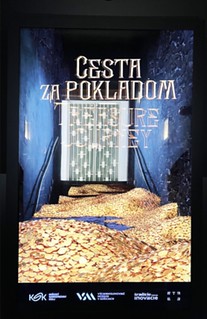 The exhibition is located in the museum's lower level and reached either by stairs or an elevator (lift) for those with mobility issues. Cesta za Pokladom, or “Treasure Journey” is the theme for the three-room exhibition.
The exhibition is located in the museum's lower level and reached either by stairs or an elevator (lift) for those with mobility issues. Cesta za Pokladom, or “Treasure Journey” is the theme for the three-room exhibition.
The first room presents information about how metals were mined and coins were made in medieval times. Additional panels give details about three additional hoards besides the famed gold treasure. The 1973 Bohdanovce Treasure was found in a ceramic jug, consisting of 12 ducats, 196 thalers, 8 half-thalers, and one 3 groschen. The youngest coin is a 1597 ducat of King Sigmund Báthory of Transylvania. Throughout the exhibition, all explanatory text is given in both Slovak and English.
The Levoca House Silver Treasure (2018-19) was found in the basement of a house near the museum. It consists of 606 silver coins from 15th-17th century.
The third hoard is the Obišovce Treasure of the One-Eyed Priest (2020). Found in a cracked jug of a church were 550 coins of which 484, copper polturas from the city of Banská Štlavnice along with 11 mining tokens. Among the copper polturas are rare specimens minted in 1687.
The second room's exhibits form a timeline of major numismatic events of the region. Starting with European coinage at the start of the millennium, the timeline progresses with periods for the introduction of the denarius (1001), groschen (1301), thalers (1526-1553), Hungarian Coins of Maria Theresa (1740), Convention and Viennese currency (1754), Revolution and Monetary Disruption (1848), Federal Currency and Austrian Currency (1857-1866), and ending with the Koruna (Krone) Currency Period (1892-1912). With each era, representative examples of gold and silver coins are displayed.
Walls that display the numismatic timeline from the start of the millennium to the Koruna (Krone) Currency Period.
At the conclusion of the numismatic timeline, there is a safe containing 12 gold bars, coins, and bundles of old Austro-Hungarian currency. A scale and video display allows visitors to weigh themselves and the equivalent “gold value” is then displayed.
The final room, the highlight of the exhibition, is the showcasing of the hoard's 2,920 gold coins from 16 different European regions in a bank vault-like room. Visitors have to enter through a bank vault-like door.
Once inside, the many coins are spread out over panels, which are divided by region, and each coin is numbered for identification.
| Region | Number | Included Dates |
|---|---|---|
| Hungary | 1,187 | 1402-1679 |
| Transylvania | 251 | 1559-1657 |
| Bohemia | 26 | 1584-1650 |
| Austria | 24 | 1544-1656 |
| Salzburg | 31 | 1543-1652 |
| Silesia | 23 | 1540-1674 |
| Poland | 111 | 1555-1676 |
| Germany | 198 | 1497-1672 |
| Sweden | 5 | 1656-1662 |
| Denmark | 8 | 1645-1673 |
| England | 1 | 1654 |
| Belgium | 1 | 1654 |
| France | 2 | 1654 |
| Italy | 22 | 1602-1649 |
| Spain | 13 | 1474-1556 |
| Netherlands | 1,017 | 1595-1674 |
Even though the exact year the hoard was hidden is not known, the newest of the coins (1679) dates back to the reign of the Holy Roman Emperor Leopold I, suggesting 1679 or shortly after.
The gold coins from Spain.
32 coins from mixed regions are displayed separately in a decorative pattern.
In addition to the 2,920 gold coins, the hoard includes three medals and a 84-inch (2.14m) long gold Renaissance chain. In all, the Kosice Gold Treasure totals 25.3 pounds (11.5 kilograms).
The Košice Gold Treasure exhibit is very well curated and should not be missed when visiting Košice. My only complaint is that the black walls and minimal lighting in the pathways make it difficult for one who walks with a cane and has trouble seeing in low light levels. Also, the entrance to the gold treasure is through a low vault door. The museum, located at 2 Námestie Maratónu mieru (Peace Marathon Square), is open Tuesday-Saturday from 9am to 5pm. Admission to the museum is €5.
VOCABULARY TERM: REMODEL, REMODELED
Here's another entry from Dick Johnson's Encyclopedia of Coin and Medal Terminology. I added the images. -Editor
Remodel, Remodeled. To model again; to prepare another model because some change needs to be performed in design, portrait, or lettering. Most often an artist is asked to remodel his design because of an error caught by the editor, or a change dictated by client or circumstances (as a change of client's name or date appearing on the item). The editor will give instructions for the artist to correct the error and submit a second or subsequent model. Remodeling is only in the model stage; it differs from retooling for changes once a die has been completed (and found to require some change).
Extensive remodeling occurred in the 1960s. Prior to this time industrial medals showed factory buildings complete with smokestacks. Belching smoke from a smokestack implied industrial vitality and activity prior to World War II. But with the rising movement of environmental awareness smoke became abhorrent. It had to be removed from medal designs; sculptors were asked to remodel and remove the smoke (and often the smokestacks!). This was an example not only of a change in symbology but of political correctness influencing medallic art.
How remodeling of an existing medal is accomplished. First step in remodeling is a search to find the pattern for the side of the die to be corrected. Seldom, if ever, is the original plaster model still in existence, but this could be used. If not, the dieshell is found and a plaster casting is made from this. Corrections could be made in the plaster by removing any unwanted relief, correcting any lettering, changing the logo, or whatever change is ordered.
After final touchup of the plaster surface, a new galvano dieshell would be made (by electrodeposition), and a new die cut from the finished dieshell. Despite the many number of steps this is a better method than trying to retool the surface of the old die (grinding off unwanted detail and repunching correct lettering). Such a treatment of an old die is often unsatisfactory but this occurred infrequently until the end of the 19th century.
In the event the original plaster model or galvano dieshell is not in existence, the sculptor must create a new model using an existing medal or drawing as a guide. In every one of these instances a new variety would be created, to the delight of collectors and numismatists. Another example of remodeling is illustrated in the entry contraposition.
For their choice of a medal to be distributed to the members of the United States Assay Commission for 1959 members of the engraving department at the Philadelphia Mint chose to use a portrait of Lincoln – after all it was the 150th anniversary of Lincoln's birth.
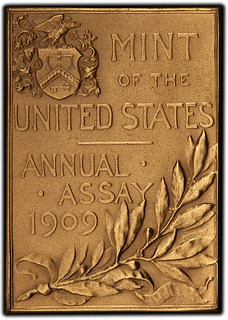 They chose an existing stunning portrait by George
Morgan (from his Presidential Medal, PR-12). For the
reverse they harkened back to Morgan's 1909 Assay Medal.
There was only one problem. The Lincoln Presidential
Medal was round, the Assay Medal was a rectangular
plaquette.
They chose an existing stunning portrait by George
Morgan (from his Presidential Medal, PR-12). For the
reverse they harkened back to Morgan's 1909 Assay Medal.
There was only one problem. The Lincoln Presidential
Medal was round, the Assay Medal was a rectangular
plaquette.
Solution? Remodel the reverse design into a round format. All the elements are reproduced: Treasury seal, branches, lettering. Some artistic license was taken by adding additional foliage, but even the lettering style was retained.
This was work in clay and plaster – typical of remodeling. A galvano was made of the accepted revised version and a die cut from the galvano.
To read the complete entry on the Newman Numismatic Portal, see:
Remodel, Remodeled
(https://nnp.wustl.edu/library/dictionarydetail/516620)
LINGUISTS ABOLISH OBVERSE AND REVERSE
David Pickup passed along this important announcement on coin terminology. The Newman Portal will update Dick Johnson's Encyclopedia of Coin and Medal Terminology appropriately. -Editor
Annual Programme Reform in Linguistics For Ordinary Old Language
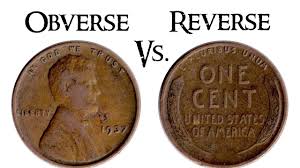 It has been decided to abolish the well-loved terms “obverse” and “reverse” for coin sides. It was felt that these words are unclear and not up to date enough. In addition, “obverse” is too strange. What does “ob” mean and “verse” is to do with poetry. “Reverse” is negative and not upbeat.
It has been decided to abolish the well-loved terms “obverse” and “reverse” for coin sides. It was felt that these words are unclear and not up to date enough. In addition, “obverse” is too strange. What does “ob” mean and “verse” is to do with poetry. “Reverse” is negative and not upbeat.
In future coins will have a “front” and “back” as these words are clear, modern and positive. The sides are easy to distinguish as back is the other side to front and front is other side to, well you guessed it, back. (Don't get us started on “heads or tails”!)
So please keep up to date and enjoy April 1st!
EMERGING COINS
E-Sylum Feature Writer and American Numismatic Biographies author Pete Smith submitted this article about coins known to have existed but unseen until discovered years later. Thanks. I added a closeup of the stars on a different example of the Starred Reverse cent, and images of a Pine Tree shilling and Shekel of Tyre. -Editor
Last week in The E-Sylum, Wayne asked about coins that were mentioned in literature but unlocated until emerging from obscurity much later. My thoughts went back to a few coins that appeared at auction after a long time off the market. The first involved a discovery I made a few years ago.
Starred Reverse Cent
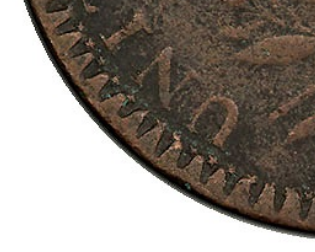 The Heritage sale of February 20, 2020, had a Starred Reverse cent as lot 3008. The lot
description stated, “This piece doesn't match any example in our photographic record of 62
different Starred Reverse cents.” I went to my photo archive and matched the coin to the
Frossard and Hays book, Varieties of United States Cents of the Year 1794, published in 1893. At
the time, only about six examples were known. Charles Steigerwalt acquired the coin in 1899
and consigned it for sale by Lyman Low on March 7, 1907, as lot 8. The 2020 sale was the first
public appearance in 113 years.
The Heritage sale of February 20, 2020, had a Starred Reverse cent as lot 3008. The lot
description stated, “This piece doesn't match any example in our photographic record of 62
different Starred Reverse cents.” I went to my photo archive and matched the coin to the
Frossard and Hays book, Varieties of United States Cents of the Year 1794, published in 1893. At
the time, only about six examples were known. Charles Steigerwalt acquired the coin in 1899
and consigned it for sale by Lyman Low on March 7, 1907, as lot 8. The 2020 sale was the first
public appearance in 113 years.
1792 Pattern Cent (Judd-2)
My thoughts turned next to a 1792 small pattern cent (Judd-2) that emerged from obscurity in
2004. Heirs of Oliver Wolcott (1726-1797) brought it to the 2004 ANA convention. Wolcott had
been a signer of the Declaration of Independence. In 1792, he was Governor of Connecticut. The
coin was consigned to Ira and Larry Goldberg for sale in May 2005 as lot 3462. After being off
the market for 213 years, the coin was sold twice more in 2008 and 2016.
1894-S Dime
In 1894, Hallie Daggett walked into the local drug store for a dish of ice cream. She paid for it
with an 1894-S dime given by her father John Daggett, Superintendent of the San Francisco
Mint.
In 1954, eleven-year-old Kelly Oliver was putting dimes into a Whitman holder. He noticed that his 1894-S dime did not fit in the holder because there was a blue cardboard plug in the spot. He took the coin into Gimbels Department Store in 1957 where Robert Friedberg bought it for $2.40. It appeared in a 1980 Steve Ivy sale, a 1981 Bowers & Ruddy sale and a 1989 Bowers & Merena sale. It had been in relative obscurity for 86 years.
The Hull-Sewell Pine Tree Shilling Hoard.
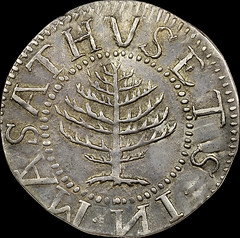 Silversmith John Hull (1624-1683) produced Pine Tree Shillings for Massachusetts Bay Colony
dated 1652. By the time his daughter Hannah was born, the family had already lost four children
as infants. Two more infant deaths would follow. When surviving daughter Hannah Quincy Hull
(1657-1717) was married to Samuel Sewell (1652-1730) on February 28, 1676, John gave the
couple a dowry estimated to be 125 pounds of Pine Tree Shillings worth about £500.
Silversmith John Hull (1624-1683) produced Pine Tree Shillings for Massachusetts Bay Colony
dated 1652. By the time his daughter Hannah was born, the family had already lost four children
as infants. Two more infant deaths would follow. When surviving daughter Hannah Quincy Hull
(1657-1717) was married to Samuel Sewell (1652-1730) on February 28, 1676, John gave the
couple a dowry estimated to be 125 pounds of Pine Tree Shillings worth about £500.
This was immortalized by Nathaniel Hawthorn in The Pine Tree Shilling, first published in The New Yorker on May 15, 1841. In the Hawthorne story, the daughter was called Betsy and described as plump as a plum pudding. She sat on a balance sale while her father piled her weight in Pine Tree Shillings on the other side. It is believed that the author embellished the story a bit, as writers often do.
Samuel Sewell and Hannah lost eight children as infants. Samuel put some of the dowry into his business and became a wealthy merchant. What wasn't spent was passed down through the generations as the Hull-Sewell hoard. As the value of the coins grew, descendants sold off some of the coins.
The remaining hoard was absorbed into the Richard Picker collection sold by Stack's on October 24, 1984. This was the first public sale of the coins in 308 years. Unfortunately, the Hull-Sewell provenance is not mentioned in the sale.
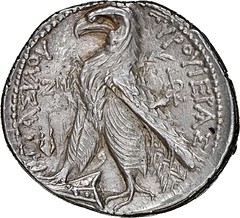 The Thirty Pieces of Silver
The Thirty Pieces of Silver
In 1973, an auction company in Tel Aviv offered a thirty-coin lot. The description included this
text, “The thirty pieces of silver paid to Judas to betray Christ. Phoenicia, city of Tyre. Mixed
dates, Civic Year 135-157.” The numismatic reference is the Bible, verse Matthew 26:15. This
would have been the first public sale in about 1940 years.
The auction company did not provide a pedigree to verify the claim. I suspect that verification was not possible.
Thanks! What other rare coins can boast "I once was lost, but now I'm found?" Surely there must be others. Readers? -Editor
CARL SUBAK COLLECTION OF ROMAN QUINARII
In her email Newsletter #227 this week, dealer and NBS Board Member Shanna Schmidt wrote about the upcoming Numismatica Ars Classica (NAC) Spring sale of the collection of Roman Quinarii of her late friend Carl Subak. We're republishing her introduction to the catalog here with permission. -Editor
As many know, Carl was a longtime numismatist and friend to me. He died in 2022 at the age of 103. Among the coins Carl treasured, Roman quinarii ranked high. I would like to share my forward to the catalog below. His son Jon also wrote a lovely forward but I'll leave that for when the catalog is published.
 I am honored and humbled to write the introduction of this catalog. Carl Hans Subak (1919-2022) was a dear family friend and mentor. Carl has been a presence in my entire life, as he was also close with my father, Harlan Berk, and even knew my mother, Ellen, since she was 18 years old. However, I only truly got to know Carl when I was a young adult living in London in 1996, working as an apprentice in the coin business. This is where the first of our many lunches took place.
I am honored and humbled to write the introduction of this catalog. Carl Hans Subak (1919-2022) was a dear family friend and mentor. Carl has been a presence in my entire life, as he was also close with my father, Harlan Berk, and even knew my mother, Ellen, since she was 18 years old. However, I only truly got to know Carl when I was a young adult living in London in 1996, working as an apprentice in the coin business. This is where the first of our many lunches took place.
Years later, starting in 2005, we met regularly for lunch at The Italian Village in Chicago, where Carl had a regular table nestled in the upstairs dining area. There, we shared many stories; I asked Carl about his years in the coin trade, and he asked me about the current auction market. Carl knew names from the past that we only now see in auction catalogs – people like Erich and Herbert Cahn, Leo Mildenberg, and Pierre Strauss. He told stories about how he nabbed his first significant collection from George Bauer in the 1950's. He used every penny he had at the time, approximately $27,500, to win the sealed bid.
When Carl turned 100 years old, I started a series of videos where I began to document his life. Carl granted my request with eagerness. He wanted me to share his story with others, and I promised him that I would. I now get to honor that promise.
Carl was a gentleman: quiet, kind, and well-spoken. When you got to know him, you quickly realized he was not interested in being the center of attention. Perhaps this was due to a traumatic yet heroic story of survival. If Carl were still alive, he certainly would not want me to dwell on this, but I feel it is essential to never forget. Carl came from a prosperous Jewish family living on the Austrian/Czech border during the Austrian Hungarian Empire. His family worked in the leather business and was even recognized as a Kaiserliche König Gesellschaft (often abbreviated as k.k. or k.u.k.) in Austria-Hungary, which meant "Imperial-Royal" and designated the authorities and state institutions of the Austrian Empire before 1867 until 1918. Carl was born in January 1919; just one month later, the last Kaiser of the Austrian Hungarian Empire, Charles I (the great-nephew of Franz Joseph) was formally dethroned.
His childhood home was close to the Roman site of Carnuntum, where workers on the property routinely found coins of the period. With his father's approval, Carl could pick coins from the jar where the coins were later stored. Unfortunately, he never found any of Regalianus or his wife, Dryantilla in that jar! This was the beginning of Carl's love for Roman coinage. Carl's father was born in 1881. He eventually ran the dry goods/textile business as a tenant farmer. Carl mentioned that he contracted with the International Harvester Company, a James Deering company known for farming machinery. As Carl's family had money, he was able to attend a good school in Vienna.
In 1935, at the age of 16, he attended the celebrated Franz Trau sale held in Vienna, where he purchased his first Roman coin, a denarius of Gordian III. Carl explained that he was probably 20 years younger than most of the participants at the auction. Just following the sale, he met members of the Vienna Coin Club and was asked to join their monthly meetings. Eventually, the relationship with one of the club members (who was a member of the National Socialist party but not a Nazi) would prove helpful in getting his collection shipped out of Nazi Austria and into the United States, actually arriving one month before his emigration. Carl did make a point of mentioning that the coin club didn't like Nazis and would not allow them to be part of the club.
In March 1938, when Carl was almost 20 years old, he went into a local park in Vienna, where he found a sign that restricted Jews from sitting on the benches. He decided it was time to leave. One month later, he left his family and home behind. His one sister and only sibling was a few years old and was on a gap year in Italy, so she eventually arrived in the U.S. shortly before Carl. He never saw his parents or surviving grandparents again. They were killed towards the end of the war. I asked Carl why his parents didn't also leave when he went. He relayed it was difficult for older people to get papers to emigrate, and they also didn't want to leave his maternal grandmother, with whom his mother was quite close. This situation likely led to Carl's desire never to own property in the U.S. He always wanted a quick exit if necessary.
From 1938 until he arrived in the U.S. in 1939, Carl lived in Riga, Latvia, and shortly thereafter in London, waiting until his number came up (they had a quota system in the U.S., and one had to wait until papers were granted). Once he arrived in the U.S., Carl almost immediately became a soldier in the army. He was first assigned to infantry and as an engineer, for which he was wholly unqualified (his assessment). The army quickly realized that Carl was a German speaker and asked him to enter the intelligence corps. He was sent to a specialized school called Intelligence Forward in Germany.
Later he was sent to England to learn from the British, where a group tracked important Nazis. He was set to be sent to Berlin to work when his commanding officer decided to work directly with the British on monitoring as they were doing a suitable job. Interestingly, Carl's group was the first Americans sent to Berlin after the war. Where was Carl? He missed this momentous event by one day as he was mountain climbing in Wales (Carl always loved mountain climbing). Carl later met his wife Eileen during a trip to Seattle, where he lived with his sister and her family following the war's end.
Carl eventually worked with The Sears Roebuck & Co., a prominent chain store and mail-order company. This led to his move to Chicago in 1949 and finally settling in Oak Park, Illinois, a short distance from the city (and where I have lived with my family since 2005).
Of course, we are here to celebrate Carl's love of quinarii. His son Jon will explain his collection and how he came to appreciate this niche area of Roman coinage.
Carl was so much more than I have written here, but foremost for me, I will always remember him as a good and dear friend, I was blessed to spend a few wonderful days with Carl before he died in February 2022 at the ripe old age of 103. When he was lucid, he reverted to his native German, and I replied likewise. I'll cherish every moment I spent with Carl for my entire life. He was an individual worth remembering. I hope this catalog becomes a reference for Roman Quinarius and that a small part of his story lives on through these pages.
May his memory be a blessing.
To read earlier E-Sylum articles, see:
BOOK REVIEW: ROMAN QUINARII BY CATHY E. KING
(https://www.coinbooks.org/esylum_v10n46a05.html)
NOTES FROM E-SYLUM READERS: JANUARY 27, 2019 :
Carl Subak Photo
(https://www.coinbooks.org/v22/esylum_v22n04a14.html)
CARL H. SUBAK (1919-2022)
(https://www.coinbooks.org/v25/esylum_v25n08a05.html)
CARL SUBAK AND THE HEBERDEN COIN ROOM
(https://www.coinbooks.org/v27/esylum_v27n36a18.html)
TREASURE TALK WITH BOB EVANS, EPISODE 2.1
In January, our good friend Bob Evans began publishing a series of blog articles on the Finest Known website detailing his experience as co-discoverer and curator of the treasures recovered from the wreck of the S.S. Central America. Subject of the book "Ship of Gold", many exhibits, countless interviews and articles, books and auction catalogs feature the legendary haul of gold coins, bars, nuggets, gold dust and more from the 1857 shipwreck. Here's another excerpt - see the complete article online. -Editor
40 years ago, I immersed myself in the S.S. Central America Project. My neighbor, Tommy Thompson, had done some historical research related to a shipwreck and treasure from 1857, a ship I had never known before. He enlisted me to join him, and that ship and treasure became major figures in my life.
While reading the historical newspaper accounts of the treasure, I repeatedly encountered the word “specie.” As a geologist and paleontologist (my university studies) I was very familiar with “species,” the term both singular and plural for particular animals or plants. But the term “specie?” This was something a little different.
Looking it up, in an actual book dictionary, (since we used those back four decades ago,) revealed that it meant “coined money.” OK. That was good enough. The 1857 newspapers referred to “the treasure” and “the specie” as if they were interchangeable terms, so as far we were concerned specie meant coins.
I was not a numismatist. Not yet. When I was a kid, I briefly dabbled in very low-end coin collecting, looking for S-mints among jars and boxes of “pennies.” But it didn't last long, and I moved into other pursuits: birdwatching and fossil collecting.
25 years later, I came back into numismatics from the top down, starting in 1988 with our discovery of the S.S. Central America treasure and its thousands of mint-state $20 gold coins. Fresh out of Gold Rush San Francisco, this numismatic time capsule revealed details of those boom times that are not told in the written word.
But before 1988, I did a little research about what we might find. I perused some coin books in the Columbus Metropolitan Library, the “Red Book” (A Guide to United States Coins,) and the “Green Coin Book.”
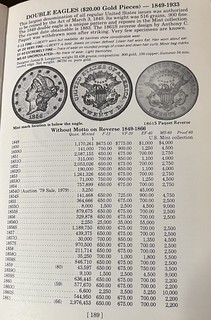 I xeroxed and shared the pertinent pages with my colleagues, Thompson and his friend Barry Schatz, who had joined our early project thinktank. Their eyes widened and brightened wide as they saw the prices on some of the rarities. “Wow! Are there really coins worth $50,000? And they were made in 1856… we could find a bunch!”
I xeroxed and shared the pertinent pages with my colleagues, Thompson and his friend Barry Schatz, who had joined our early project thinktank. Their eyes widened and brightened wide as they saw the prices on some of the rarities. “Wow! Are there really coins worth $50,000? And they were made in 1856… we could find a bunch!”
I cautioned that we could not assume we would find any rarities, certainly not in large quantities, and we should just use these valuations for conservative estimates. Still, it seemed likely that the listed commercial shipment, over $1.219 million in 1857, would be worth at least tens of millions, possibly a hundred million dollars or more.
While organizing the project and the expeditions in the mid-1980s, that was all we needed to know. The treasure was a “black box” of gigantic value. To speculate further was of no value. We focused our research on other more immediately important questions. Where was the shipwreck? Could we design or hire equipment to find it? What kind of condition would it be in? Could we find the treasure once we found the shipwreck? Could we design or hire equipment to recover the treasure?
It's a fascinating story, well worth a full read even though today we know the answers to those questions - yes, they could and did find and recover the treasure. Here's one of the first photos of the wreck, with piles of gold coins and ingots on the ocean floor. -Editor
To read the complete article, see:
Treasure Talk: Episode 2 Part 1 THE AMAZING GOLD BARS
(https://finestknown.com/treasure-talk-episode-2-part-1the-amazing-gold-bars/)
For the complete series, see:
Category Archives: Treasure Talk with Bob Evans
(https://finestknown.com/treasure-talk-with-bob-evans/)
To read the earlier E-Sylum article, see:
TREASURE TALK WITH BOB EVANS, EPISODE 1
(https://www.coinbooks.org/v28/esylum_v28n12a12.html)
ANS TO ESTABLISH COLLIER PRIZE
Proceeds from the upcoming James M. Collier Collection Sale will be used to establish the Collier Prize in Ancient Numismatics in perpetuity at the ANS. -Garrett
Collection of James M. Collier at Auction to Benefit the ANS Collier Prize
The American Numismatic Society is pleased to announce that the Collection of James M. Collier will be offered at auction by Nomos AG (Zurich, Switzerland) from April 5-6, 2025. All proceeds from the collection will establish an endowment at the ANS to offer the Collier Prize in Ancient Numismatics in perpetuity. The Collier Prize was established in 2020 with the generous support of ANS Trustee Carole Anne Menzi Collier in honor of her late husband Professor James M. Collier. It is the most substantial financial award supporting scholarship in ancient numismatics. Nomos AG Auction 35 will include many fine examples of ancient Greek, Roman, and Byzantine coins from the Collier collection.
James Collier initially taught art history before fully dedicating himself to painting, in which he drew inspiration both from the rich tapestry of art history, but also from the world around him. His work is deeply influenced by his understanding of artistic periods, in particular of the Renaissance, yet he remained attuned to the nuances of objects he loved, such as coins and medals, blending the two to create a unique and compelling visual narrative. His coin collection contains many of the great highlights of ancient numismatics, such as an exceptional group of coins of Syracuse, including a stunning decadrachm of Euainetos (lot. 169). In the extensive Roman series, there are many highlights, such as a remarkable specimen of the a stunning decadrachm of Euainetos (lot. 169). In the extensive Roman series, there are many highlights, such as a remarkable specimen of the sesterius of Nero with his lost triumphal arch (lot 659) and a full set of the twelve Caesars in silver (lot. 640).
The Collier Prize is awarded biennially to the best single or multi-authored work in the field of ancient numismatics, with the winner(s) receiving $20,000 (to be split equally for a multi-authored work). The prize was first awarded in 2021 to Roman Imperial Coinage (RIC) II.3 (Spink, 2020) by Richard Abdy and Peter Mittag, and most recently to Moneda Ibérica (http://monedaiberica.org/), developed and edited by Manuel Gozalbes Fernández de Palencia, Pere Pau Ripollès Alegre, Alejandro Peña, and Juan Francisco Onielfa, in a ceremony on March 18, 2025, at the ANS in New York City.
The Sydney F. Martin Executive Director, Dr. Ute Wartenberg Kagan, commented on the auction: “We are most grateful for the generous support of our trustee, Carole Anne Menzi Collier, and Nomos AG for hosting this auction. The proceeds will help the ANS continue to enrich the study of ancient numismatics by supporting this prize and honoring significant research publications in the field.”
The auction will begin at 14:00 CEST (8:00 AM ET) on April 5. For more information, visit www.nomosag.com/auction. We hope that you will support the ANS by bidding in the auction!
THE TRAVELLER COLLECTION
This amazing story has already been making the rounds of the popular press. Here's the press release from Numismatica Ars Classica (NAC) about their upcoming sale of the Traveller Collection. -Editor
The Traveller Collection: Historic coin collection, buried for 50 years, set for record-breaking auction
- The Traveller Collection, with an insurance value in excess of $100 million, is the most valuable numismatic collection ever to come to auction in its entirety.
- The Traveller Collection of coins will be auctioned by Numismatica Ars Classica over the next three years, with the first auction taking place on 20 May 2025.
- The collection covers over 100 territories around the world, including coins from ancient times to the modern era.
- The largest part of the collection was buried underground to be hidden from the Nazis and for over 50 years and was completely unknown to coin collectors and scholars, with every lot coming to market for the first time in nearly a century.
- The first auction will focus on the machine-struck British coins in the collection, including masterpieces of British coinage.
Numismatica Ars Classica is delighted to announce the sale of The Traveller Collection, a unique collection of coins with extraordinary provenance, which is coming to the market 85 years after the last coin was purchased.
The Traveller Collection, comprising rare and highly sought-after pieces from around the world, will be auctioned over the next three years in what is believed to be the most significant ever sale of a single numismatic collection. The estimated insurance value of the collection exceeds $100 million, making this by far the most prized collection of coins to be sold at auction in the history of numismatics.
Buried underground in aluminium boxes at the collector's property for over five decades, the coins had been carefully packed and stored in cigar boxes. The collection spans all geographical areas and contains exceptionally rare coins often in a state of preservation never seen in modern times. Several types have never been offered in a public auction, highlighting their considerable rarity.
The collection was assembled in the 1930s and is made up of around 15,000 coins, including numerous examples which can be considered the finest specimen in private hands. The collector began to purchase gold coins after the Wall Street Crash in 1929, soon developing a taste for coins with great historical interest, beauty and rarity. No longer directly involved in the day-to-day running of his family business, the collector and his new wife spent the next decade travelling extensively across Europe, North and South America, acquiring rare and historically significant coins as they went and carefully documenting each purchase in a detailed archive.
At the end of this extended honeymoon, the collector settled in a European location. When the threat of Nazi invasion became imminent, he chose to stay rather than flee the country, likely in part due to the difficulty of transporting his collection. Instead, the collector buried the coins on his property, but tragically died shortly after the Nazis invaded. The coins remained buried for over 50 years before finally being retrieved by his heirs and placed in a bank vault and later presented to Numismatica Ars Classica.
Thanks to the meticulous records kept by the collector as well as the research by the team of experts assembled by NAC for this monumental cataloguing endeavour, many of the coins can be traced back to the auctions of some of the greatest collections of the late nineteenth and early twentieth centuries.
Highlights from the collection include some of the rarest and most prized coins by numismatic collectors. Examples include:
- A remarkable 100 ducat gold coin of Ferdinand III of Habsburg, minted in 1629 when he was Archduke of Austria, King of Hungary, Croatia and Bohemia. This 100 Ducat weighs an extraordinary 348.5g of fine gold, making it one of the largest denominations of European gold coins ever minted. Unseen at auction after World War II, the coin has an auction estimate of CHF 1,200,000 (GBP £1,048,854)
- A 70 ducat coin of the Polish king Sigismund III, minted in 1621 and weighing around 243g of gold. A similar example of this coin is notable for achieving the highest auction price for a Polish coin of all time. This example has an auction estimate of CHF 450,000 (GBP £394,260)
- An Australian 1 Ounce Port Philip coin, a pattern coin from a series minted to commemorate the 1854 Melbourne Exhibition and later exhibited at the Paris Exhibition of 1855. Minted by the ‘Kangaroo Office', one of the earliest mints created to establish an Australian currency, the coin fittingly features a depiction of a Kangaroo. As one of the rarest and most significant coins in Australian history, this coin has an auction estimate of CHF 250,000 (GBP £218,511).
- An exceedingly rare set of 5 Tomans, minted in Tehran and Isfahan in the late 18th and early 19th century by Agha Mohammad Khan Qajar. These coins were used to store wealth and were later transferred to the Russian Tsar following Persia's defeat by Russia in 1828. Only 5 complete sets are known, one of which is in the Ashmolean Museum in Oxford. The series consists of a 50 Toman, weighing just over 400g of gold, three 20 Toman and two 10 Toman. Last seen at auction 30 years ago, the estimate of this series of Persian coins is 1.5 -2 million CHF (GBP £1,314,180 – £1,752,260).
- An Athens gold stater, struck in 296 BC by the tyrant Lachares. Lachares tore off the gold from the famous chryso-elephantine statue of Athena Parthenos in the Parthenon in Athens in order to pay his troops during the siege of the city by Demetrius, King of Macedonia. This coin has an estimate of 125,000 CHF (GBP £109,515)
- Pattern Five Guinea piece of George III dated 1777. No large gold coins were struck for currency during the reign of Britain's longest ruling king, and this pattern was created for a proposed Five Guinea piece which never came to fruition. This is the last possible date for collectors of Five Guinea pieces to own and one of only seven specimens believed to exist. The coin has an estimate of 300,000 CHF (GBP £262,900).
The first auction in this remarkable series will feature the British machine-struck coins and medallions from the Traveller Collection, dating from Charles II all the way to a specimen set created for George VI in 1937. Another key example from this auction, one of the highlights of the entire Traveller collection, is a high grade Una and the Lion £5 by William Wyon, considered to be one of the most beautiful coins ever made. The £5 has an auction estimate of 250,000 CHF (GBP 218,921). Other highlights from this first auction will be announced in due course. Coins from the first auction will be on display at Numismatica Ars Classica's London office throughout April.
Arturo Russo, Director of Numismatica Ars Classica, said: “We are incredibly proud to offer the extraordinary Traveller Collection at auction. The vast range and superb quality of the coins offered, the sheer number of great rarities and the fascinating story of the collection's formation will make these sales a landmark in the history of numismatics. The catalogues of the Traveller Collection will serve as an important reference for the future collectors and scholars."
David Guest, director of David Guest Numismatics, and consultant to the collection, said: “When it came to cataloguing the British coins from the Traveller Collection I had to keep pinching myself to make sure I wasn't dreaming. Not only was the quality exceptional but many of the coins before me were of types not known to have been offered for sale in over 80 years and, in some cases, completely unrecorded”
About Numismatica Ars Classica AG
Founded in Zurich in 1988, Numismatica Ars Classica has gained a reputation as one of the world's leading and most trusted firms for ancient coins, primarily, but not limited to, Greek, Roman, Byzantine and Italian coins.
Over the years NAC has sold some of the most important collections in the history of Numismatics and houses one of the largest and most varied selections of ancient coins in the world at their London branch in Mayfair.
NAC currently holds two annual auctions for ancient coins, one in Spring and one in Autumn. The sales are always held at the exclusive Hotel Baur au Lac in Zurich. NAC has offices in London, Milan and Zurich.
Website: www.arsclassicacoins.com
To read the CNN article, see:
$100 million coin collection, buried for decades, up for auction
(https://www.cnn.com/2025/03/27/style/buried-coin-collection-auction-scli-intl/index.html)
LEN AUGSBURGER'S NUMISMATIC DIARY: MARCH 30, 2025
This week we've got double diaries - Len and Wayne's Excellent Numismatic Adventures. First up is Len Augsburger, who made an interesting research side trip on his way to the Whitman Baltimore Spring Expo. -Editor
Whitman Baltimore Expo Report
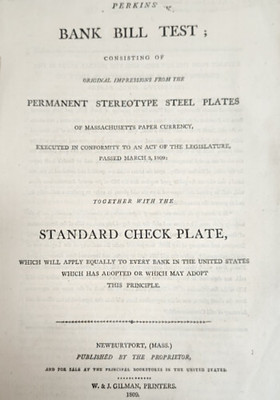 My Baltimore show trip began Thursday, March 27, at the Hagley Library in Wilmington, DE, about a 45-minute train ride from Baltimore's Penn Station. The Hagley features a picturesque reading room, more inspiring than industrial spaces found elsewhere. I was issued a reader card that will get added to an ever-growing collection of such things. Research targets included two copies of the rare Jacob Perkins Bank Bill Test (1809), one of the most prized items in the American numismatic literature catalog. This was the first American paper money counterfeit detector, the forerunner of the Laban Heath series and other 19th century detectors. A full article on the Bank Bill Test will appear in a future issue of The Asylum. At the Hagley I also viewed an account book of the U.S. chief coiner Henry Voigt, covering portions of his personal accounts from 1798 to 1837. Although not completely Mint-related, “Interesting” portions of this manuscript volume were shared with researchers Julia Purdy and Neil Musante.
My Baltimore show trip began Thursday, March 27, at the Hagley Library in Wilmington, DE, about a 45-minute train ride from Baltimore's Penn Station. The Hagley features a picturesque reading room, more inspiring than industrial spaces found elsewhere. I was issued a reader card that will get added to an ever-growing collection of such things. Research targets included two copies of the rare Jacob Perkins Bank Bill Test (1809), one of the most prized items in the American numismatic literature catalog. This was the first American paper money counterfeit detector, the forerunner of the Laban Heath series and other 19th century detectors. A full article on the Bank Bill Test will appear in a future issue of The Asylum. At the Hagley I also viewed an account book of the U.S. chief coiner Henry Voigt, covering portions of his personal accounts from 1798 to 1837. Although not completely Mint-related, “Interesting” portions of this manuscript volume were shared with researchers Julia Purdy and Neil Musante.
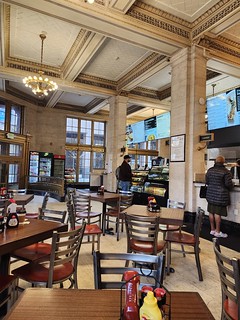 Friday kicked off with a visit to David and Dad's Café for breakfast. Long time attenders of the Baltimore show will recall Burke's restaurant on Lombard Stret, an old-time Baltimore mainstay that sadly closed in 2011 to make way for a chain convenience store. Happily, David & Dad's at Charles and Lexington Streets is a credible replacement. Operating in an old bank lobby, the ambiance is immediately apparent, and the breakfast menu isn't far behind. You can even order a modern coffee drink, which would have been a non-starter at Burke's.
Friday kicked off with a visit to David and Dad's Café for breakfast. Long time attenders of the Baltimore show will recall Burke's restaurant on Lombard Stret, an old-time Baltimore mainstay that sadly closed in 2011 to make way for a chain convenience store. Happily, David & Dad's at Charles and Lexington Streets is a credible replacement. Operating in an old bank lobby, the ambiance is immediately apparent, and the breakfast menu isn't far behind. You can even order a modern coffee drink, which would have been a non-starter at Burke's.
From there it was off to the Liberty Seated Collectors Club meeting at the Baltimore Convention Center. Education Director John Frost and Editor/Publisher Greg Johnson presented updates on club news and the recent publication of Gobrecht Journal no. 152, followed by a presentation from me on the early New Orleans Mint. The LSCC is presenting a four-day course on the New Orleans Mint at the upcoming ANA Summer Seminar, June 22-25, and a small number of seats remain available.
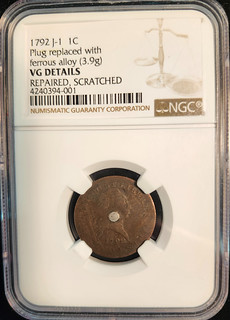 On entering the bourse, Julian Leidman occupied his customary front row center table. The rest of the day was all too short before leaving at 4:30pm to catch a flight home. I had conversations with Greg Bennick, Neil Musante, Charles Davis, Greg Johnson, John Kraljevich, Tony Terranova, Bruce Hagen, Wayne Homren, Jim Matthews, Stu & Maureen Levine, Craig Sholley, and several others. Brian Hendelson's case included the “Modesto Police Department” example of the Judd-1 silver center cent, a piece that sold for the bargain sum of $400 in 2006 in a police auction. Although not the nicest example, Brian's price was no doubt significantly higher! I found a single piece for my coin collection, an XF 1844-O half eagle from David Kahn.
On entering the bourse, Julian Leidman occupied his customary front row center table. The rest of the day was all too short before leaving at 4:30pm to catch a flight home. I had conversations with Greg Bennick, Neil Musante, Charles Davis, Greg Johnson, John Kraljevich, Tony Terranova, Bruce Hagen, Wayne Homren, Jim Matthews, Stu & Maureen Levine, Craig Sholley, and several others. Brian Hendelson's case included the “Modesto Police Department” example of the Judd-1 silver center cent, a piece that sold for the bargain sum of $400 in 2006 in a police auction. Although not the nicest example, Brian's price was no doubt significantly higher! I found a single piece for my coin collection, an XF 1844-O half eagle from David Kahn.
For Newman Portal scanning, Kerry Wetterstrom brought several early issues of the Voice of the Turtle, the publication of the Ancient Coin Club of America. Newman Portal has lately been incorporating more literature on ancient coins, and these will be a welcome addition. Why a turtle? Google tells us “The ancient coins that famously depicted a sea turtle were those of Aegina, a Greek island in the Aegean Sea, around 600 BCE. These coins became a prominent symbol of the island's maritime power….[these] were among the earliest known coins used as a medium of trade in the ancient world.” Other possible material loans were discussed throughout the day and will no doubt appear on NNP in the coming months.
Link to Liberty Seated Collectors Club home page:
https://lsccweb.org/
Link to ANA Summer Seminar course catalog:
https://6180285.fs1.hubspotusercontent-na1.net/hubfs/6180285/2025%20Summer%20Seminar/Summer-Seminar-Catalog-2025.pdf
WAYNE'S NUMISMATIC DIARY: MARCH 30, 2025
So here's my perspective on the Baltimore show. I went on Friday, March 28 and got there earlier than usual, after deciding not to go to work in the morning. I arrived and signed in around 10:30. Upon walking into the bourse I recognized my first fellow numismatist - Jim Halperin of Heritage was having a conversation with someone just inside the door. Not wanting to interrupt, I moved on to the Whitman tables where editor Jeff Garrett and publisher John Feigenbaum were signing copies of the latest Red Book.
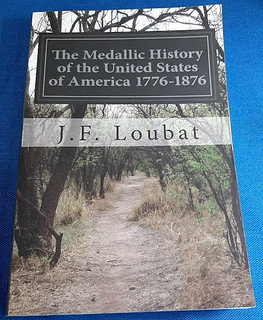 While in the Whitman section I talked for a bit with Lori Kraft, general manager of Whitman Expos and a current Governor of the American Numismatic Association.
I called E-Sylum supporter Bob Rhue who had a numismatic literature question for me. I missed him, but later caught up with him at the table he shared with Andy Lustig.
While in the Whitman section I talked for a bit with Lori Kraft, general manager of Whitman Expos and a current Governor of the American Numismatic Association.
I called E-Sylum supporter Bob Rhue who had a numismatic literature question for me. I missed him, but later caught up with him at the table he shared with Andy Lustig.
But speaking of numismatic literature, among my next stops was the table of longtime literature dealer Charlie Davis, where visiting with him and table partner Neil Musante was Newman Numismatic Portal Project Coordinator Len Augsburger. One topic of conversation was this print-on-demand version of the out-of-copyright Loubat book on medals. Anyone familiar with the originals knows these are tall, large format books, and this printed version squeezed the text down to where it's barely readable. This reprint is only of the text volume - there are no plates, although they are referred to in the text.
I managed to catch Neil blinking in the first shot - sorry!
George Washington University student Kellen Hoard stopped by the table briefly while I was there - he only had about half an hour left to visit the show before needing to head back to campus. Here are some more shots of the offerings at Charlie's table.
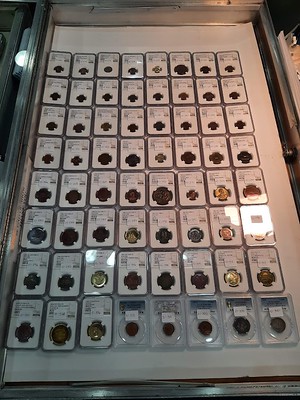 As usual, some of our E-Sylum sponsors were immersed in conversation with customers when I swung by their tables. I did have a chance to talk with Jon Sullivan and consider one of the error coins in his stock. I caught Julian Leidman for a minute as he crossed the bourse floor. I got David Sunshine on the phone; he was at the show but our paths didn't cross. I totally missed Doug Winter, David Kahn, John Kraljevich, Northeast Numismatics and others.
Anyway, many thanks to all of our regular advertisers and contributors.
We couldn't do this without you!
As usual, some of our E-Sylum sponsors were immersed in conversation with customers when I swung by their tables. I did have a chance to talk with Jon Sullivan and consider one of the error coins in his stock. I caught Julian Leidman for a minute as he crossed the bourse floor. I got David Sunshine on the phone; he was at the show but our paths didn't cross. I totally missed Doug Winter, David Kahn, John Kraljevich, Northeast Numismatics and others.
Anyway, many thanks to all of our regular advertisers and contributors.
We couldn't do this without you!
While walking around I briefly bumped into Stu Levine (a literal fist bump), Craig Sholley and others. I had a chance to stop briefly at Tony Terranova's table and chat a bit.
When I first came by dealer Steve Hayden's table, he and collector Alan Weinberg were busy looking through groups of tokens. I returned in a quieter moment to talk with the two of them. At right is a case holding the lots in Steve's upcoming auction sale.
Around 1pm I connected with Len Augsburger and we sat down with beverages in the convention center lobby. I bought a turkey sandwich for lunch. I ate it, but it wasn't appetizing. At least the conversation was good - we discussed a number of Newman Portal and NBS topics. In addition to running NNP, he's President of the Numismatic Bibliomania Society.
Back on the bourse floor I had an aisle encounter with Ken McDevitt of Leu Numismatik USA. We talked a bit about the E-Sylum and potentially advertising an upcoming sale. Ken asked what I collected these days and I told him about the off-center Liberty Nickel I'd bought from Tom Caldwell at Northeast Numismatics at the previous Whitman show. I'd decided to pass on an undated off-center Seated Liberty Quarter at Jon Sullivan's table, and I didn't think one coin made a collection. Two would be a trend, but three I guess I could call a collection.
I also had a chance to sit down with Greg Bennick and discuss some Newman Portal business and his planned visit to our Nummis Nova dinner next month.
Greg was sharing a table with ancient coin dealer Mike Bezayiff. I stopped by the table again before leaving the show around 3pm. I ended up with another surprise impulse purchase - a recently slabbed 1873 Arrows Dime with two errors - it's about 5% off-center and the reverse was struck through what may have been a splinter of wood. It's seen circulation, but still a nice example. Greg had brought it to sell at the show. It grew on me the more I looked at it. While I prefer more dramatic off-centering, the double error is something notable and makes for an interesting coin. Plus, it's from the landmark year 1873. So now I've got two error coins! Here's the PCGS photo and a photo of Greg holding the coin to commemorate the transaction. Thanks for the opportunity!
That's all folks - it took about an hour and a half to get home to Northern Virginia for dinner, and I was able to work at my computer, make travel arrangements for the Oklahoma City ANA in August, and get another walk in before the evening was over. It was a short, but memorable show.
MINT DIRECTORS DIEHL AND MOY ON BITCOIN
Perhaps former U.S. Mint Director Ventris Gibson will follow in the footsteps of her fellow former Directors and become a pundit for gold sales. Here's an article quoting former Directors Diehl and Moy. -Editor
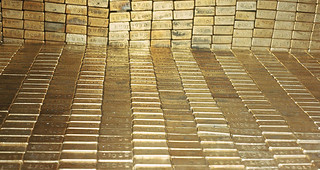 Could the Trump administration be preparing to use the United States' gold bullion reserves to fund their proposed Strategic Bitcoin Reserve?
Could the Trump administration be preparing to use the United States' gold bullion reserves to fund their proposed Strategic Bitcoin Reserve?
Bo Hines, the Executive Director of the Presidential Working Group on Digital Assets, suggested in a recent interview that revaluing government gold was one of the proposals on the table.
“We view Bitcoin as being digital gold,” Hines told Coindesk's Christine Lee at the Blockworks Digital Asset Summit in New York City. “That's why we set up the Strategic Bitcoin Reserve in the way that we did. It has intrinsic stored value that's traditionally accepted, and we feel like it's in the best interest of Americans to hold on to this asset long-term and accumulate as much as we can get.”
 “That's why we've likened this to digital gold and talked about building the digital Fort Knox for the United States,” he added.
“That's why we've likened this to digital gold and talked about building the digital Fort Knox for the United States,” he added.
And the Trump administration appears to be considering the contents of the original Fort Knox to fund the digital one.
Edmund Moy served as the 38th Director of the United States Mint from 2006 to 2011. Appointed during the second term of Republican President George W. Bush, he continued in his role through most of the first term of Democratic President Barack Obama, a bipartisan tenure which is not always the case for Mint directors.
“Congress, under the gold standard, set the value of gold through law,” Moy told Kitco News. “When Nixon took us off the gold standard and prevented convertibility in 1972, the law at the time said that the value of gold was $42.22. So that is the statutory value, the book value, of that gold on the United States' books. Congress has not changed that value of gold and said, ‘It's market value.'”
And Moy doesn't believe the U.S. government will ever revalue it, only to turn around and spend the added value on something else. “We want to keep all the gold that we have as an asset,” he said.
Philip Diehl was appointed director of the United States Mint in 1994 and served through to the end of Bill Clinton's presidency in 2000. During his term, the Mint increased the profits it returned to taxpayers from $727 million to $2.6 billion. Diehl also coauthored the law authorizing the Mint to produce the American Platinum Eagle bullion coin, the nation's first platinum coin.
Diehl told Kitco News that he's not convinced the gold certificates scheme between Treasury and the Federal Reserve would actually result in new money, even on paper.
“I don't understand how they see that mechanism,” Diehl said. “Now, the reality is that it's entirely possible in the last 25 years since I left the Treasury Department, that the law has changed on how that would occur. But from the time when I was there, I just don't see how it's anything other than an accounting change on the books.”
Still, Diehl acknowledged that President Trump will likely get what he wants from the agencies and departments he controls, but that still leaves the coequal branch of Congress to contend with.
“I'm highly skeptical that Senator Lummis' legislation could pass,” he said. “Number one, it has no momentum from its filing in 2023. She ended up getting five or six co-sponsors last year, and I think she has the same five co-sponsors this year.”
To read the complete article, see:
Will Trump use U.S. gold reserves to buy Bitcoin? Former Mint Directors Diehl and Moy say it's a lousy trade
(https://www.gold-eagle.com/will-trump-use-us-gold-reserves-buy-bitcoin-former-mint-directors-diehl-and-moy-say-it%E2%80%99s-lousy-trade)
FORT KNOX GOLD TO BE SOLD!
Steve Shupe passed along this Associated Press report on President Trump's recently signed Executive Order to sell the gold in Fort Knox and return the money to the American people. Thanks. -Garrett
AP 3/28/25- President Trump today signed his latest Executive Order (EO-14250). Trump states that with the ever increasing price of gold, that this is a good time to sell all the gold in Fort Knox. Gold has reached an all-time high of $3101.24 today. This will recover more than a trillion dollars of value at current market rates. He stated that since he has been president gold has climbed a really huge, huge amount. The United States currently holds the largest supply of gold with 8,133.46 metric tons. Trump said he is planning on returning the amount recovered to the American people in the planned checks from DOGE. Musk has found that more than $26M dollars can be saved by the government each year by no longer protecting this useless asset.
As numismatists know, Fort Knox also stores the confiscated 1933 Saint Gaudens $20 gold coins and the Sacagawea gold dollars that were sent into space.
When asked about these coins, president Trump stated that he will probably just use the gold Sacagawea dollars for golf ball markers since they were not supposed to be made and they were never monetized. He stated that he really doesn't like the front but the eagle is great and represents his ball flying through the air. When a reporter mentioned that he could re-stamp the coins with his likeness on the front, he thought it was a great idea and stated that he would look into that.
He stated that he plans to visit Fort Knox next week with his team and he might pick up a couple of them at that time for his personal use, after all he is the president. He also stated that he would use his sharpie to initial them, so everyone knows that it is his ball marker.
To read the complete article, see:
Trump Orders Fort Knox Gold Sale
(https://finance.yahoo.com/news/trump-orders-fort-knox-gold-sale-180016888.html)
THE MARY KAWENA PUKUI DOLLAR
The 2025 Native American dollar shows the portrait of Native Hawaiian scholar and educator Mary Kawena Pukui. Here is an article from Big Island Now about her life. -Garrett
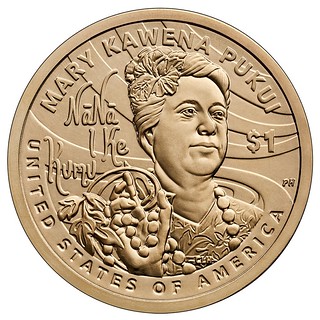 Mary Kawena Pukui, who was born in Ka?u in 1895, spent her life working as a Native Hawaiian scholar and educator.
Mary Kawena Pukui, who was born in Ka?u in 1895, spent her life working as a Native Hawaiian scholar and educator.
She also was a hula expert and wrote sourcebooks on Hawaiian cultural practices, concepts and beliefs traditionally passed through mo?olelo (orally transmitted stories). And, in 1995, she was even inducted into the Hawaiian Music Hall of Fame as a composer.
Now, her legacy is being honored nationally. She was named by the U.S. Mint as its 2025 Native American $1 coin honoree.
Pelehonuamea Harman, Pukui's great-granddaughter and the director of Native Hawaiian engagement for the University of Hawai?i at Hilo, has been involved in the process since 2023 and was able to choose the final artwork with her family.
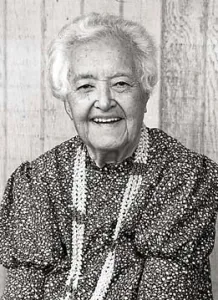 The coin features Pukui with a hibiscus in her hair, a kukui nut lei, and kukui leaves in her hand, symbolizing Hawaiian knowledge. Alongside her profile is the title of her series of books, “Nana I Ke Kumu,” which she produced with Queen Lili?uokalani Children's Center to document Hawaiian cultural practices and beliefs.
The coin features Pukui with a hibiscus in her hair, a kukui nut lei, and kukui leaves in her hand, symbolizing Hawaiian knowledge. Alongside her profile is the title of her series of books, “Nana I Ke Kumu,” which she produced with Queen Lili?uokalani Children's Center to document Hawaiian cultural practices and beliefs.
After choosing the art that best depicted Pukui, one of the changes Harman and her family requested from the U.S. Mint was the removal of the English translation for the statement and book title.
“We asked them to take the translation out because we wanted people to delve deeper and encourage people to learn more about our culture,” Harman said. “Hopefully, this coin is a source of inspiration for young people and our people who are spread out all over the planet.
“We want it to be a conversation starter, a history lesson in the form of a coin for non-Hawaiians and people who don't know our story.”
I enjoy local publication articles about coin designers and coin subjects. We often learn details not published elsewhere. I asked Google for a translation of "Nana I Ke Kumu" - it means "Look At The Teacher." -Editor
To read the complete article, see:
New $1 coin honors Native Hawaiian scholar, author, composer, hula practioner from Big Island
(https://bigislandnow.com/2025/03/26/new-1-coin-honors-native-hawaiian-scholar-author-composer-hula-practioner-from-big-island/)
ON AI-GENERATED COIN IMAGES
Gary Beals has been experimenting with AI-generated images and shared these thoughts. Thank you. -Editor
I have had fun creating high quality images that might end up in a coin book.
Working with MS Copilot is like hanging out with a brilliant friend who is also mentally unstable and over-confident in his abilities. All of the artwork has excellent, thoughtful details and elements yet can be totally off-base for the purpose being attempted by the person submitting instructions.
Oddly, I asked for a Muera Huerta Mexico revolution silver coin and got the real deal. Someone must have put one it Copilot's memory. But I could not find out how to upload material for some future graphics use.
There is a huge technical base for how information and images are gathered and presented. I am not a scientist. I am a guy who ran an advertising and publishing company in San Diego for more than 30 years. When I see a piece of original artwork I usually think of the hours involved in creating it and the wages an illustrator deserves for creating it. From that standpoint AI images can be breathtaking. Especially when they can be delivered in seconds.
Somehow AI can see hundreds of thousands of images it uses to compose graphic art elements upon request. But as soon as it creates an image it is blind to it. It cannot see what it generated. Therefore, the additions or corrections we would expect to do with a human are not possible with AI. Or at least with MS Copilot as I was using it. You cannot refer to an image just created and ask the robot to change a background color or add an element or reduce a portion of the image or change the style of the work. Your AI robot cannot see its own work.
The good news is that humans skilled in digital graphic design work can make corrections and changes to the artwork.
If some flaky character wanted to crank out a book on coin collecting AI could save him lots of time and money by producing unique, original artwork. Accurate numismatically? Not bloody likely.
If he wanted AI to create the cover of his book that might work.
Why it loses its mind with words I have no idea. Nice bust.
This castle was a half hour drive from my home in Spain. I asked for a drawing of it and got —
Doing shipwreck coins story, it can provide local color....
I asked for a bald eagle in line art and was very pleased --
Fly press coin minting it knows nothing but it still created machines --
Sometimes the device goes nuts and you discover a computer can also lose its mind. The various attempts to create artwork of fly press operations was a failure. What became clear in this process is that with AI it would be easy to create confusing fake images with text implying that a mechanical operation could be carried out in a certain way when in reality the art is total nonsense.
AI gave me this in research phase -- but could not use this image to create anything similar.
I would gladly have paid $500 or so for this original line drawing a few years ago. This was free. © GB too!
This is a good version of the Hotel Del Coronado here in San Diego -- I asked for the dolphins.
It can go nuts with stylized graphics as might become a medal.
A coin book could have artwork in no time flat. I asked for teens with coin albums. -- which the robot knows nothing about.
Someone loaded this $1000 coin into Copilot.
I asked for a carpenter in 1880. Old boy is overdressed.
I asked for a California Mission with farming, It is not a specific church but great illustration.
I asked for useless cents overflowing a vault. Note it has words problem.
Have fun!
AI capabilities are improving rapidly, and there are other image generators out there, including DALL-E, Midjourney, Stable Diffusion, and more, each with its own strengths and weaknesses. I understand Ideogram boosts the accuracy of text, and Stable Diffusion allows for more customization and control of your images. It's an exciting but frustrating time, requiring a lot of experimentation. And not all of these are free, so some investment of money is required in addition to time. But definitely fun. Thanks, Gary!
And right on time, the AI industry has begun rolling out new versions with breakthrough improvements in image generation. The state-of-the-art is advancing rapidly. Here's a post published this morning by Professor Ethan Mollick of Wharton, one of the most influential people in AI. See the complete article online if you're interested in experimenting with these tools. -Editor
Over the past two weeks, first Google and then OpenAI rolled out their multimodal image generation abilities. This is a big deal. Previously, when a Large Language Model AI generated an image, it wasn't really the LLM doing the work. Instead, the AI would send a text prompt to a separate image generation tool and show you what came back. The AI creates the text prompt, but another, less intelligent system creates the image. For example, if prompted “show me a room with no elephants in it, make sure to annotate the image to show me why there are no possible elephants” the less intelligent image generation system would see the word elephant multiple times and add them to the picture. As a result, AI image generations were pretty mediocre with distorted text and random elements; sometimes fun, but rarely useful.
Multimodal image generation, on the other hand, lets the AI directly control the image being made. While there are lots of variations (and the companies keep some of their methods secret), in multimodal image generation, images are created in the same way that LLMs create text, a token at a time. Instead of adding individual words to make a sentence, the AI creates the image in individual pieces, one after another, that are assembled into a whole picture. This lets the AI create much more impressive, exacting images. Not only are you guaranteed no elephants, but the final results of this image creation process reflect the intelligence of the LLM's “thinking”, as well as clear writing and precise control.
One section particularly resonated with me - "Is it okay to reproduce the hard-won style of other artists using AI? Who owns the resulting art?" -Editor
If you have been following the online discussion over these new image generators, you probably noticed that I haven't demonstrated their most viral use - doing style transfer, where people ask AI to convert photos into images that look like they were made for the Simpsons or by Studio Ghibli. These sorts of application highlight all of the complexities of using AI for art: Is it okay to reproduce the hard-won style of other artists using AI? Who owns the resulting art? Who profits from it? Which artists are in the training data for AI, and what is the legal and ethical status of using copyrighted work for training? These were important questions before multimodal AI, but now developing answers to them is increasingly urgent.
Yet it is clear that what has happened to text will happen to images, and eventually video and 3D environments. These multimodal systems are reshaping the landscape of visual creation, offering powerful new capabilities while raising legitimate questions about creative ownership and authenticity. The line between human and AI creation will continue to blur, pushing us to reconsider what constitutes originality in a world where anyone can generate sophisticated visuals with a few prompts. Some creative professions will adapt; others may be unchanged, and still others may transform entirely. As with any significant technological shift, we'll need well-considered frameworks to navigate the complex terrain ahead. The question isn't whether these tools will change visual media, but whether we'll be thoughtful enough to shape that change intentionally.
Style transfer was precisely the subject of the article my money artist friend J.S.G. Boggs explored in his April 1993 Chicago-Kent Law Review article "Who Owns This?" -Editor
Boggs wrote:
Nothing gets me quite so angry as seeing a visual artist whose style is copied and, in effect, stolen. And it bewilders me that people can get away with it. It happens most often with artists who gain a certain degree of recognition, gained in large part by their style. All the pop artists suffered this, and it is an entirely different situation than using a small part of some other artist's work. In fact, this is a very big problem...
- My original work must be acknowledged.
- The new work must be properly identified as an additive work.
- I must receive my fair share of the proceeds.
To read the complete article, see:
No elephants: Breakthroughs in image generation
(https://www.oneusefulthing.org/p/no-elephants-breakthroughs-in-image)
To read earlier E-Sylum articles, see:
NEW BOOK: GUIDE TO BECOMING A COIN DEALER
(https://www.coinbooks.org/v26/esylum_v26n51a06.html)
AI-GENERATED COIN BOOK COVERS
(https://www.coinbooks.org/v26/esylum_v26n52a11.html)
ABOUT THIS ISSUE: MARCH 30, 2025
We had a bit of glitch last week. Bruce had a technical issue which prevented him from publishing the E-Sylum email. Luckily, he was able to handle all the other weekly chores for preparing the issue and adding it to our website. So Monday morning I could just press a button and send off the email. Bruce is back in business now, so situation normal again.
As you could see in my Diary article, I spent a good part of Friday at the Whitman Baltimore Spring Expo. Always a good time, and perfect for visiting with old friends and E-Sylum supporters. I'm fortunate to live near such a large regional show. -Editor
Wayne Homren
Wayne Homren is the founding editor of The E-Sylum and a consultant for the Newman Numismatic Portal. His collecting interests at various times included U.S. Encased Postage Stamps, merchant counterstamps, Pittsburgh Obsolete paper money, Civil War tokens and scrip, Carnegie Hero Medals, charge coins and numismatic literature. He also collects and has given presentations on the work of Money Artist J.S.G. Boggs. In the non-numismatic world he's worked in artificial intelligence, data science, and as a Program Manager for the U.S. Department of Defense.
Garrett Ziss
Garrett Ziss is a numismatic collector and researcher, with a focus on American paper money and early U.S. silver and copper coins. He is also a part-time U.S. coin cataloger for Heritage Auctions. Garrett assists Editor Wayne Homren by editing and formatting a selection of articles and images each week. When he's not engaged in numismatics, Garrett is a Senior Honors student at the University of Pittsburgh.
Pete Smith
Numismatic researcher and author Pete Smith of Minnesota has written about early American coppers, Vermont coinage, numismatic literature, tokens and medals, the history of the U.S. Mint and much more. Author of American Numismatic Biographies, he contributes original articles to The E-Sylum often highlighting interesting figures in American numismatic history.
Greg Bennick
Greg Bennick (www.gregbennick.com) is a keynote speaker and long time coin collector with a focus on major mint error coins and US counterstamps. He is on the board of both CONECA and TAMS and enjoys having in-depth conversations with prominent numismatists from all areas of the hobby. Have ideas for other interviewees? Contact him anytime on the web or via instagram
@minterrors.
John Nebel
Numismatist, photographer, and ANS Board member and Fellow John Nebel of Boulder, CO helped the ANA and other clubs like NBS get online in the early days of the internet, hosting websites gratis through his Computer Systems Design Co. To this day he hosts some 50 ANA member club sites along with our
coinbooks.org site, making the club and our E-Sylum archive available to collectors and researchers worldwide.
Bruce Perdue
Encased coinage collector (encasedcoins.info) Bruce Perdue of Aurora, Illinois has been the volunteer NBS webmaster from its early days and works each week to add the latest E-Sylum issue to our archive and send out the email announcement.

